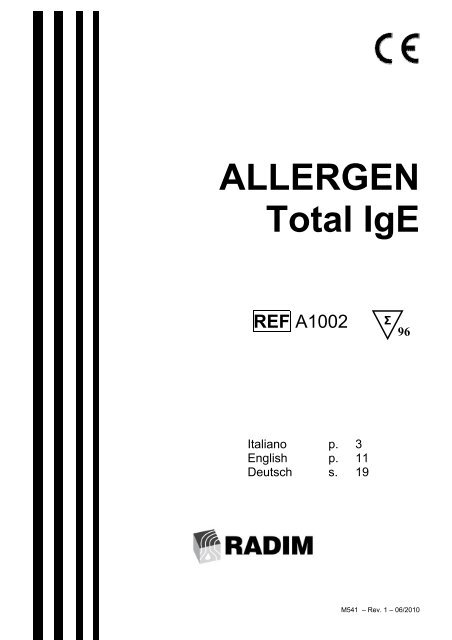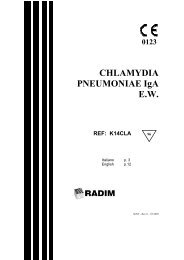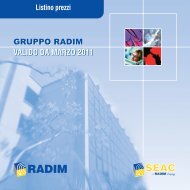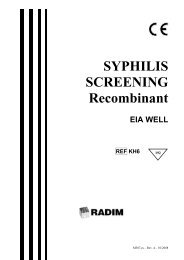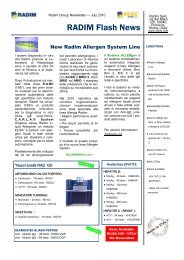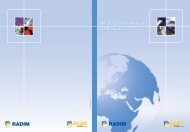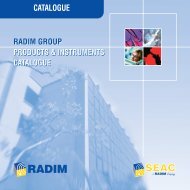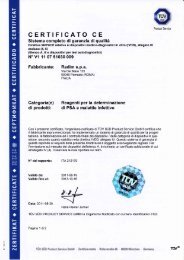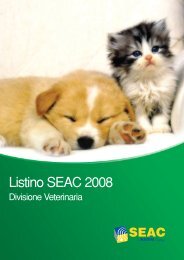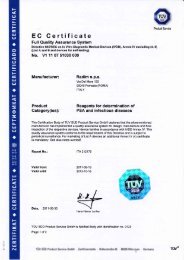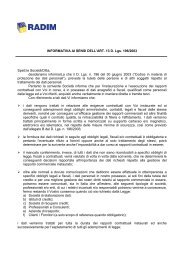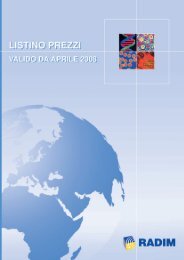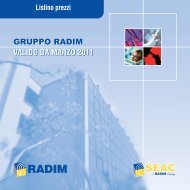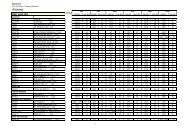ALLERGEN Total IgE REF - Radim S.p.A.
ALLERGEN Total IgE REF - Radim S.p.A.
ALLERGEN Total IgE REF - Radim S.p.A.
Create successful ePaper yourself
Turn your PDF publications into a flip-book with our unique Google optimized e-Paper software.
<strong>ALLERGEN</strong><br />
<strong>Total</strong> <strong>IgE</strong><br />
<strong>REF</strong> A1002<br />
Italiano p. 3<br />
English p. 11<br />
Deutsch s. 19<br />
Σ 96<br />
M541 – Rev. 1 – 06/2010
COMPONENTI DEL KIT - KIT COMPONENTS - KIT KOMPONENTEN<br />
Reag. Quant.<br />
MT PLATE<br />
CONJ│BIOT<br />
CAL│A…F<br />
BUF│INC<br />
DIL│SPE<br />
CONJ│HRP<br />
SUBS│TMB<br />
SOLN│STOP<br />
1 x 96<br />
1 x 13 ml<br />
6 x 0.5 ml<br />
1 x 18 ml<br />
1 x 10 ml<br />
1 x 13 ml<br />
1 x 13 ml<br />
1 x 13 ml<br />
Pronto per l’uso.<br />
Ready for use.<br />
Gebrauchsfertig.<br />
Pronto per l’uso.<br />
Ready for use.<br />
Gebrauchsfertig.<br />
Pronto per l’uso.<br />
Ready for use.<br />
Gebrauchsfertig.<br />
Pronto per l’uso.<br />
Ready for use.<br />
Gebrauchsfertig.<br />
Pronto per l’uso.<br />
Ready for use.<br />
Gebrauchsfertig.<br />
Pronto per l’uso.<br />
Ready for use.<br />
Gebrauchsfertig.<br />
Pronto per l’uso.<br />
Ready for use.<br />
Gebrauchsfertig.<br />
Pronto per l’uso.<br />
Ready for use.<br />
Gebrauchsfertig.<br />
BUF│WASH│10X 1 x 100 ml Conc., Konz.: 10x<br />
"Le Istruzioni per l'uso tradotte nelle altre lingue di interesse sono consultabili sul sito Internet all'indirizzo<br />
www.radim.com".<br />
"The instructions for use available in the other languages of interest can be viewed on our website<br />
www.radim.com".<br />
"Οι οδηγίες χρήσης μεταφρασμένες στις άλλες ενδιαφερόμενες γλώσσες όπως επίσης στην ηλεκτρονική<br />
διεύθυνση www.radim.com".<br />
"In den anderen Sprachen von Interesse ist die Bedienungsanleitung kann auf der Website unter der<br />
Adresse www.radim.com konsultiertwerden".<br />
"Le mode d’emploi dans les autres langues intéressées est consultable sur le site Internet à l'adresse<br />
www.radim.com".<br />
"Las instrucciones de uso traducidas en los otros idiomas de interés se pueden consultar en nuestro<br />
sitio Internet www.radim.com".<br />
"As instruções de uso traduzidas nos outros idiomas de interesse podem ser consultadas no nosso site<br />
Internet, ao endereço www.radim.com."<br />
A1002 – <strong>ALLERGEN</strong> <strong>Total</strong> <strong>IgE</strong><br />
M541 – Rev. 1 – 06/2010 – Pag. 2/32
DOSAGGIO IMMUNOENZIMATICO PER LA DETERMINAZIONE QUANTITATIVA DELLE <strong>IgE</strong><br />
TOTALI NEL SIERO E PLASMA UMANO<br />
PER USO DIAGNOSTICO IN VITRO<br />
1.0 USO PREVISTO<br />
Il kit <strong>ALLERGEN</strong> <strong>Total</strong> <strong>IgE</strong> è un test immunoenzimatico per la determinazione quantitativa delle<br />
immunoglobuline totali di tipo E (<strong>IgE</strong>) in siero o plasma umano. È esclusivamente per uso diagnostico in<br />
vitro ed i risultati ottenuti devono essere usati in associazione ad altri dati clinici.<br />
2.0 SOMMARIO E SPIEGAZIONE DEL TEST<br />
Le immunoglobuline di classe E (<strong>IgE</strong>) contengono 2 tipi di catene polipeptidiche, hanno un peso<br />
molecolare di circa 200.000 (1) e si legano alla superficie dei mastociti e dei granulociti basofili. Il legame<br />
degli allergeni alle <strong>IgE</strong> legate alle cellule provoca il rilascio di istamina e di altre sostanze vasoattive da<br />
cui scaturisce una cascata di eventi nota come reazione allergica. È stato dimostrato che la maggior<br />
parte dei pazienti con patologie allergiche atopiche, come l’asma atopica, la dermatite atopica e la<br />
febbre da fieno, mostrano un aumento dei livelli di <strong>IgE</strong> nel sangue (4,5,6). Individui non allergici hanno<br />
concentrazioni ampiamente variabili; durante l’infanzia esse normalmente aumentano, raggiungendo<br />
nella seconda decade della vita i livelli tipici degli adulti (7, 8). La misurazione delle concentrazioni delle<br />
<strong>IgE</strong> totali è importante nella prima indagine delle allergie infantili e come strumento diagnostico per<br />
prevedere future manifestazioni atopiche (9, 10, 11). Un aumento significativo può essere riscontrato<br />
non solo nei pazienti allergici, ma anche in casi di mieloma da <strong>IgE</strong>, aspergillosi polmonare e durante lo<br />
stadio attivo di infezioni da parassiti (12, 13). Si riscontrano livelli aumentati di <strong>IgE</strong> in caso di<br />
ipergammaglobulinemia, malattie autoimmuni, coliti ulcerose, epatite, cancro e malaria (14).<br />
3.0 PRINCIPIO DEL TEST<br />
L’<strong>ALLERGEN</strong> <strong>Total</strong> <strong>IgE</strong> si basa sulla tecnica immunoenzimatica di tipo “sandwich”. Il campione da<br />
testare viene aggiunto nei pozzetti delle microstrips, nei quali sono stati immobilizzati degli anticorpi<br />
monoclonali anti-<strong>IgE</strong> umane. Durante la prima incubazione le anti-<strong>IgE</strong> della fase solida catturano le <strong>IgE</strong><br />
del campione. L’aggiunta e la successiva incubazione con il coniugato Anti-<strong>IgE</strong>-biotina portano alla<br />
formazione del sandwich: fase solida anti-<strong>IgE</strong> : <strong>IgE</strong> : Anti-<strong>IgE</strong>-Biotina. Le ulteriori incubazioni con il<br />
coniugato Streptavidina-Perossidasi e con il Substrato Cromogeno, rispettivamente, portano allo<br />
sviluppo del colore blu. La reazione enzimatica viene successivamente bloccata con la Soluzione<br />
Bloccante che fa virare la soluzione al giallo. Il valore di assorbanza va letto con un fotometro a 450 nm:<br />
la concentrazione delle <strong>IgE</strong> del campione è direttamente correlata all’intensità del colore.<br />
4.0 COMPONENTI DEL KIT<br />
MT PLATE<br />
CONJ│BIOT<br />
CAL│A…F<br />
BUF│INC<br />
DIL│SPE<br />
Reagenti<br />
Micropiastra sensibilizzata con anti-<strong>IgE</strong>: una busta contenente una micropiastra<br />
di 12 strip da 8 pozzetti ciascuna, sensibilizzati con anticorpi monoclonali anti-<strong>IgE</strong>.<br />
Conservare le strip inutilizzate a 2…8°C nell’apposita busta di plastica con<br />
l’essiccante.<br />
Coniugato anti-<strong>IgE</strong>-Biotina: un flacone (13 ml) di Coniugato anti-<strong>IgE</strong>-Biotina in<br />
tampone Tris, pH 8.1, conservanti e stabilizzanti. Pronto per l’uso.<br />
Calibratori per <strong>IgE</strong> <strong>Total</strong>i: 6 flaconi di 0.5 ml ognuno. I flaconi contengono <strong>IgE</strong><br />
umane in siero di cavallo, con Proclin 300 allo 0.01% come conservante. Le<br />
concentrazioni di <strong>IgE</strong> sono: 0 - 10 - 50 - 250 - 500 - 1000 KIU/L. (WHO 2 nd IRP<br />
75/502). Pronti per l’uso.<br />
Tampone di Incubazione: un flacone (18 ml) contenente TRIS buffer, pH 8.4, con<br />
Tween 20 allo 0.1% e Proclin 300 allo 0.005% come conservanti. Pronto per l’uso.<br />
Diluente campioni: un flacone (10 ml) di diluente campioni contenente siero di<br />
cavallo, con Proclin 300 allo 0.01% come conservante. Pronto per l’uso.<br />
A1002 – <strong>ALLERGEN</strong> <strong>Total</strong> <strong>IgE</strong><br />
M541 – Rev. 1 – 06/2010 – Pag. 3/32
CONJ│HRP<br />
SUBS│TMB<br />
SOLN│STOP<br />
BUF│WASH│10X<br />
Coniugato HRP-Streptavidina: un flacone (13 ml) di coniugato Streptavidina-<br />
Perossidasi in un tampone colorato di rosso, a pH 5.5, addizionato di 0.001%<br />
Proclin 300 come conservante. Pronto per l’uso.<br />
Substrato HS: un flacone (13 ml) di una miscela stabilizzata di TMB (3,3' 5,5'<br />
Tetrametilbenzidina) e H2O2 (Perossido di Idrogeno). Pronto per l’uso.<br />
Soluzione Bloccante: un flacone (13 ml) di acido solforico 0.3 M. Pronto per<br />
l’uso.<br />
Soluzione di Lavaggio conc. 10X: un flacone (100 ml) di soluzione di lavaggio,<br />
concentrata 10X addizionata di Amphoteric. B 2.5 μg/ml. Preparare la soluzione di<br />
lavoro miscelando il contenuto del flacone con 900 ml di acqua distillata.<br />
5.0 CONSERVAZIONE E STABILITÁ DOPO PRIMA APERTURA<br />
Durante il trasporto e lo stoccaggio conservare tutti i componenti del kit a 2…8°C, in accordo con le<br />
etichette del kit e i documenti di trasporto.<br />
La data di scadenza è stampata sull’etichetta esterna.<br />
Tutti i reagenti del kit sono stabili, dopo la prima apertura del kit, fino alla data di scadenza riportata<br />
sull’etichetta, se propriamente conservati a 2…8°C, o per 2 settimane a temperatura ambiente<br />
(18…25°C).<br />
6.0 MATERIALE NECESSARIO MA NON FORNITO<br />
Avvertenza: l’utilizzatore deve controllare la conformità con i requisiti del dosaggio di tutti i materiali e<br />
dei dispositivi che sono utilizzati in combinazione con il kit. Inoltre, si raccomanda di controllare<br />
periodicamente l’efficienza dei dispositivi, in accordo con le GLP e le Standard Operating Procedures<br />
(SOP).<br />
• pipette di precisione da 25 e 100 µl<br />
• lavatore automatico per micropiastre<br />
• acqua distillata di alta qualità<br />
• lettore per micropiastre che permetta letture a 450 nm, 405 nm e 620 nm (come filtro di<br />
riferimento).<br />
7.0 AVVERTENZE E PRECAUZIONI<br />
7.1 NORME DI SICUREZZA<br />
• Tutti i reagenti forniti in questo kit sono esclusivamente per uso diagnostico in vitro.<br />
• Si raccomanda l’utilizzo di questo kit solo da parte di personale con esperienza di laboratorio, in<br />
accordo con queste IFU e con le GLP.<br />
• Gli operatori devono indossare guanti e indumenti protettivi quando utilizzano sieri di pazienti e<br />
prodotti a base di siero.<br />
• Tutti i componenti di origine umana forniti nel kit sono stati ottenuti da donatori testati<br />
individualmente con metodi affidabili e sono risultati negativi per gli Anticorpi del Virus Umano<br />
dell’Immunodeficienza (HIV-Ab), per gli Antigeni di superficie dell’ Epatite B (HBsAg) e per gli<br />
Anticorpi dell’Epatite C (HCV-Ab). Tuttavia, nessun metodo può offrire completa garanzia<br />
sull’assenza del Virus dell’Epatite B (HBV), dell’Immunodeficienza Umana (HIV) e dell’Epatite C<br />
(HCV) o di altri agenti infettivi. Tali reagenti, quindi, dovrebbero essere considerati<br />
potenzialmente infetti. Si raccomanda di usare le stesse precauzioni che vengono adottate per la<br />
manipolazione dei campioni ignoti, in accordo con le procedure definite da appropriate linee<br />
guida o regolamentazioni nazionali, laddove esistono.<br />
• I calibratori contengono siero equino. Tale siero è stato ottenuto da animali sani ma, dal<br />
momento che nessun metodo può fornire la completa garanzia sull’assenza di agenti infettivi, si<br />
raccomanda di maneggiare con cautela i prodotti a base di siero.<br />
• I reagenti del kit contengono agenti antimicrobici e il Substrato HS contiene tetrametilbenzidina.<br />
Evitare il contatto con pelle e occhi. Sciacquare abbondantemente con acqua in caso di contatto.<br />
A1002 – <strong>ALLERGEN</strong> <strong>Total</strong> <strong>IgE</strong><br />
M541 – Rev. 1 – 06/2010 – Pag. 4/32
• La Soluzione bloccante contiene acido solforico 0.3 M. Evitare il contatto con pelle e occhi. In<br />
caso di contatto sciacquare subito e abbondantemente con acqua.<br />
• Non pipettare con la bocca.<br />
• Non fumare, non mangiare o applicare cosmetici nelle aree dove campioni e reagenti vengono<br />
maneggiati.<br />
• Evitare la contaminazione da microrganismi durante la dispensazione utilizzando puntali<br />
monouso.<br />
• Qualsiasi liquido venuto in contatto con materiali potenzialmente infettivi deve essere eliminato in<br />
un contenitore con un disinfettante. Lo smaltimento deve avvenire in accordo con la legislazione<br />
in vigore.<br />
7.2 PRECAUZIONI TECNICHE<br />
1. Utilizzo corretto dei reagenti e dispensazione.<br />
• Il kit deve essere impiegato esclusivamente per l’uso previsto.<br />
• Non utilizzare i reagenti oltre la data di scadenza.<br />
• Non utilizzare le strip o gli altri reagenti se la confezione è danneggiata o i liquidi sono fuoriusciti.<br />
• Nell’assemblaggio della micropiastra per il dosaggio possono essere usate strip provenienti da<br />
differenti micropiastre, ma queste devono appartenere allo stesso lotto e devono essere state<br />
sottoposte alle stesse condizioni di conservazione.<br />
• La soluzione unica di TMB/H2O2 è incolore o leggermente blu. Con il passare del tempo il<br />
substrato può diventare giallo-arancione ma ciò non altera le proprietà della soluzione.<br />
In caso di contaminazione accidentale la soluzione inizia a sviluppare una colorazione blu e deve<br />
necessariamente essere scartata.<br />
La soluzione unica TMB/H2O2 non è fotolabile. La luce solare diretta può però ossidare<br />
comunque la soluzione rendendola blu. Tale colore scompare dopo 4 ore di conservazione al<br />
buio; dopo tale periodo la soluzione può essere utilizzata.<br />
• Usare esclusivamente puntali monouso.<br />
• Prestare attenzione che non ci sia contaminazione fra i pozzetti. Mantenere tutte le pipette e il<br />
materiale usato per il coniugato completamente separato dal Substrato HS.<br />
• Prima di dispensare il Coniugato o il Substrato HS prelevare un’aliquota per il numero necessario<br />
di pozzetti, al fine di evitare il ripetuto inserimento delle pipette nei flaconi dei reagenti. Non<br />
riversare i reagenti non utilizzati all’interno dei loro flaconi.<br />
2. Conformità alla procedura e alle specifiche<br />
• I valori ottenuti devono essere sempre confrontati con quelli riportati nel certificato di Controllo di<br />
Qualità. Non usare il kit per la determinazione di valori al di fuori dell’intervallo indicato nelle<br />
istruzioni per l’uso.<br />
• Il protocollo di dosaggio deve essere seguito dettagliatamente. Osservare i tempi e la<br />
temperatura di incubazione, nonché la procedura di lavaggio: questi sono passaggi critici.<br />
• Includere il controllo positivo e quello negativo in ogni test per controllare la stabilità dei reagenti<br />
e le caratteristiche del dosaggio. Leggere anche la sezione 10.5 - Controllo di Qualità.<br />
8.0 RACCOLTA E CONSERVAZIONE DEI CAMPIONI<br />
• Per il dosaggio possono essere utilizzati sia siero che plasma. EDTA, eparina e sodio citrato<br />
possono essere utilizzati come anti-coagulanti. Tuttavia, l’impiego di eparina dovrebbe essere<br />
evitato nel caso in cui i medesimi campioni debbano essere testati, non solo per <strong>IgE</strong> totali, ma<br />
anche per <strong>IgE</strong> specifiche, in quanto questo anticoagulante potrebbe determinare una sottostima<br />
dei valori di <strong>IgE</strong> specifiche.<br />
• I campioni di sangue intero devono essere separati in globuli rossi e plasma o siero il più presto<br />
possibile dopo il prelievo per evitare l’emolisi. Si raccomanda, inoltre, di rimuovere i coaguli.<br />
A1002 – <strong>ALLERGEN</strong> <strong>Total</strong> <strong>IgE</strong><br />
M541 – Rev. 1 – 06/2010 – Pag. 5/32
• I campioni dei pazienti devono essere ottenuti tramite prelievo utilizzando le apposite provette o<br />
una siringa sterile. Osservare le usuali precauzioni per il prelievo. Se si utilizza una siringa,<br />
trasferire immediatamente il sangue nell’apposita provetta (tappo rosso piatto o separatore di<br />
siero).<br />
• Campioni di siero e plasma possono essere conservati per tutta la notte a 2...8°C; per periodi di<br />
conservazione più lunghi congelare i campioni a -20°C.<br />
• Evitare ripetuti congelamenti e scongelamenti.<br />
9.0 PROCEDURA DEL TEST<br />
Sia il metodo manuale che quello automatico, con strumenti Adaltis e <strong>Radim</strong>, necessitano dei seguenti<br />
passaggi:<br />
9.1 PREPARAZIONE DEI REAGENTI<br />
• Lasciare che i reagenti e la micropiastra raggiungano la temperatura ambiente prima dell’uso.<br />
• Riporre le strip non utilizzate nella confezione trasparente, con l’essiccante, richiudere<br />
opportunamente e conservare a 2…8°C.<br />
• Preparare la soluzione di lavaggio.<br />
9.2 PROCEDURA DI ESECUZIONE DEL TEST<br />
1. Preparare lo schema del dosaggio riservando i primi pozzetti per la curva di calibrazione.<br />
2. Pipettare 150 µl di tampone di incubazione in tutti i pozzetti.<br />
3. Pipettare 25 µl di calibratori e campioni nei pozzetti designati.<br />
4. Agitare dolcemente la micropiastra per 10 secondi evitando di far fuoriuscire il contenuto dai<br />
pozzetti.<br />
5. Incubare a 37°C per 60 min. senza coprire la micropiastra.<br />
6. Lavare 3 volte come descritto nella sezione 9.3 Note Procedurali.<br />
7. Dispensare 100 µl di coniugato anti-<strong>IgE</strong>-Biotina nei pozzetti.<br />
8. Incubare a 37°C per 30 min. senza coprire la micropiastra.<br />
9. Lavare 3 volte come descritto nella sezione 9.3 Note Procedurali.<br />
10. Dispensare 100 µl di coniugato HRP-Streptavidina nei pozzetti.<br />
11. Incubare a 37°C per 30 min. senza coprire la micropiastra.<br />
12. Lavare 3 volte come descritto nella sezione 9.3 Note Procedurali.<br />
13. Dispensare 100 µl di Substrato HS nei pozzetti.<br />
14. Incubare 15 min. a temperature ambiente.<br />
15. Aggiungere 100 µl di Soluzione Bloccante nella stessa sequenza e frequenza adottate per<br />
dispensare il Substrato e leggere a 450 e 405 nm con il filtro di riferimento selezionato a 620 nm.<br />
Leggere i valori entro 60 min.<br />
9.3 NOTE PROCEDURALI<br />
• PROCEDURA DI LAVAGGIO. Si raccomanda l’utilizzo di un lavatore automatico per<br />
micropiastre. Dopo il lavaggio sbattere delicatamente la micropiastra capovolta sulla carta<br />
assorbente, per rimuovere qualsiasi residuo di liquido, nel caso in cui il lavatore non aspiri<br />
completamente la soluzione di lavaggio. Una volta che il lavaggio è stato correttamente<br />
programmato sugli strumenti Adaltis e <strong>Radim</strong>, questo passaggio non è necessario. Effettuare<br />
almeno 3 lavaggi.<br />
• TEMPERATURA DI INCUBAZIONE. La temperatura di incubazione per tutte le reazioni<br />
immunologiche deve essere mantenuta costante a 37°C ± 1°C.<br />
• DISPENSAZIONE DELLA SOLUZIONE DI SUBSTRATO HS<br />
Per ottenere risultati precisi ed accurati è necessario dispensare il Substrato HS immediatamente<br />
dopo il lavaggio.<br />
A1002 – <strong>ALLERGEN</strong> <strong>Total</strong> <strong>IgE</strong><br />
M541 – Rev. 1 – 06/2010 – Pag. 6/32
Si raccomanda di fare attenzione alla frequenza con cui si addizionano il Substrato HS e la<br />
soluzione bloccante, fino a quando non sia stata acquisita una buona familiarità con il metodo<br />
(per es. se il Substrato HS è dispensato nei pozzetti ogni 3 secondi uno dall’altro, anche la<br />
Soluzione Bloccante deve essere dispensata nello stesso ordine e con la stessa frequenza).<br />
L’utilizzo di pipette ripetitive è particolarmente indicato.<br />
Evitare la contaminazione delle soluzioni. Non è necessaria l’incubazione al buio. Evitare<br />
comunque la diretta esposizione alla luce solare.<br />
10.0 CALCOLO DEI RISULTATI<br />
10.1 CONVERSIONE DELLE OD<br />
La densità ottica del calibratore a 500 KIU/L può essere superiore a 2.0 e quella del calibratore a 1000<br />
KIU/L può risultare intorno a 3.0. Se il lettore è in grado di leggere OD superiori a 3.0, allora è sufficiente<br />
la lettura a 450 nm (lunghezza d’onda del picco) e a 620 nm (filtro di riferimento per la sottrazione delle<br />
interferenze della plastica). Se si utilizzano lettori non in grado di leggere valori superiori a 3.0, allora<br />
l’utilizzatore può scegliere fra 2 opzioni:<br />
1. omettere dal dosaggio il calibratore a 1000 KIU/L<br />
2. includere il calibratore a 1000KIU/L ed effettuare una lettura anche a 405 nm (lunghezza alla<br />
quale si trova la spalla del picco), sottraendo sempre eventuali interferenze della plastica lette a<br />
620 nm. Identificare i pozzetti che, letti a 450 nm, presentano OD superiori a 2.0 sia tra i<br />
campioni che tra i calibratori. Selezionare le corrispondenti OD lette a 405 nm e moltiplicare per<br />
un fattore 3 (dove OD 450/OD 405= 3.0)<br />
Nota bene: il fattore 3.0 è solamente suggerito OD450 nm = OD405 nm x 3.0<br />
Per una maggiore accuratezza gli utilizzatori devono calcolare il fattore di conversione sul proprio lettore.<br />
Gli strumenti Adaltis e <strong>Radim</strong> sono già programmati per la lettura alle 3 lunghezze d’onda, con il fattore<br />
appropriato.<br />
10.2 ELABORAZIONE DEI DATI – METODO MANUALE<br />
Calcolare, come precedentemente descritto, la media delle densità ottiche a 450 nm di calibratori e<br />
campioni. Tracciare una curva di calibrazione facendo corrispondere la media delle OD con la rispettiva<br />
concentrazione di <strong>IgE</strong> (usare una scala lineare o logaritmica). Determinare la concentrazione delle <strong>IgE</strong><br />
totali del campione interpolando le OD dei campioni (a 450 nm) sulla curva di calibrazione.<br />
10.3 ELABORAZIONE DEI DATI – METODO AUTOMATICO<br />
Nel caso di utilizzo della metodica in automazione, per l’elaborazione dei dati fare riferimento alla<br />
procedura applicativa relativa a ciascuno strumento.<br />
10.4 VALIDITÁ DEL DOSAGGIO<br />
Affinché il dosaggio sia valido devono essere soddisfatti i seguenti requisiti:<br />
- le OD dei calibratori A ed F devono cadere entro intervalli accettabili, riportati nei Certificati di<br />
Analisi per ogni partita di lotti.<br />
- Per ogni singolo calibratore il rapporto fra la concentrazione calcolata e la concentrazione<br />
nominale deve cadere entro i limiti di accettabilità riportati nel Certificato di Analisi relativo a<br />
ciascun lotto di Set di calibrazione.<br />
- I risultati ottenuti per i sieri di controllo qualità devono rientrare entro i range di accettabilità: si<br />
prega di leggere anche la sezione 10.5 CONTROLLO DI QUALITÀ.<br />
10.5 CONTROLLO DI QUALITA’<br />
I risultati del controllo di qualità per il lotto del kit sono riportati nel Certificato di Analisi incluso nella<br />
confezione. Per il controllo di qualità interno si raccomanda di usare sieri di controllo a concentrazione<br />
nota che permettano di verificare il corretto funzionamento del prodotto.<br />
A1002 – <strong>ALLERGEN</strong> <strong>Total</strong> <strong>IgE</strong><br />
M541 – Rev. 1 – 06/2010 – Pag. 7/32
10.6 ELABORAZIONE PER CAMPIONI OLTRE 1000 KIU/L<br />
Se i campioni presentano OD uguali o più alte di quelle del calibratore a 1000 KIU/L, si raccomanda di<br />
ripetere il dosaggio diluendoli 1:5 o 1:10 con il Diluente Campioni. Calcolare, quindi, la giusta<br />
concentrazione moltiplicando i risultati ottenuti per 5 o per 10, in accordo con il rapporto di diluizione.<br />
Per ottenere una maggiore accuratezza è, inoltre, suggerita una diluizione 1:5 o 1:10 anche per i<br />
campioni compresi tra 500 KIU/L e 1000 KIU/L.<br />
11.0 VALORI ATTESI<br />
La gamma dei valori delle <strong>IgE</strong> è estremamente ampia per gli individui affetti e non affetti da patologie<br />
allergiche, dipendendo anche dal tipo di popolazione, per es. dall’area geografica, dal sesso e dall’età.<br />
Ne consegue che c’è una forte sovrapposizione di valori di <strong>IgE</strong> totali fra popolazioni atopiche e non<br />
atopiche ed è molto difficile definire un “limite di normalità” superiore. Si raccomanda che ogni<br />
laboratorio stabilisca i propri intervalli di riferimento per la popolazione di interesse. La letteratura<br />
disponibile fornisce le seguenti informazioni relativamente alle concentrazioni delle <strong>IgE</strong> totali nel siero<br />
umano:<br />
Media: 27.6 KIU/L<br />
Età (anni) KIU/L<br />
0 – 3
13.0 CARATTERISTICHE DEL DOSAGGIO<br />
13.1 PRECISIONE<br />
Precisione (metodo manuale)<br />
Campione Livello 1 Livello 2 Livello 3<br />
sedute 20 20 20<br />
replic./seduta 4 4 4<br />
totale replic. 80 80 80<br />
CV % intra-saggio 9.5 6.6 4.7<br />
CV % inter-saggio 10.6 5.5 4.9<br />
CV % complessivo 14.2 8.6 6.8<br />
conc. media (KIU/I) 356.5 147.4 90.5<br />
13.2 SENSIBILITA’<br />
Il limite di rilevabilità del test, definito come la concentrazione di <strong>IgE</strong> equivalente all’assorbanza media di<br />
20 replicati del calibratore 0 + 3 deviazioni standard, è 3.9 KIU/L<br />
13.3 ACCURATEZZA<br />
Test di diluizione<br />
I test di diluizione hanno fornito come CV% di inter-diluizione un intervallo compreso fra 3 e 19%.<br />
Test di recupero<br />
Due campioni sono stati addizionati con concentrazioni note di <strong>IgE</strong> umane e testati nuovamente. I<br />
risultati sono riportati nella seguente tabella:<br />
Campione Aggiunto<br />
(KIU/L)<br />
1<br />
2<br />
Atteso<br />
(KIU/L)<br />
Trovato<br />
(KIU/L)<br />
Recupero %<br />
(Trovato/Atteso x<br />
100)<br />
0,00 7,41<br />
111,11 117,70 105,79 90%<br />
200,00 205,93 198,70 96%<br />
333,33 338,27 339,86 100%<br />
500,00 503,71 498,70 99%<br />
666.66 669,14 640,12 96%<br />
media 96%<br />
0,00 8,04<br />
111,11 118,26 108,73 92%<br />
200,00 206,43 197,49 96%<br />
333,33 338,69 305,61 90%<br />
500,00 504,02 438,84 87%<br />
666.66 669,35 665,65 99%<br />
media 93%<br />
Correlazione con altri metodi<br />
I dati ottenuti con questo test sui campioni di siero sono stati confrontati con il metodo Pharmacia UNI<br />
CAP® System.<br />
La regressione lineare ha dato i seguenti risultati:<br />
n = 98 y= 0.9489x + 27.56 r 2<br />
= 0.87<br />
A1002 – <strong>ALLERGEN</strong> <strong>Total</strong> <strong>IgE</strong><br />
M541 – Rev. 1 – 06/2010 – Pag. 9/32
14.0 AUTOMAZIONE<br />
Questo test per <strong>IgE</strong> <strong>Total</strong>i può essere completamente automatizzato con analizzatori per micropiastra<br />
Adaltis e <strong>Radim</strong> (provvisti di un software specifico per l’allergia).<br />
Per un uso corretto e per ulteriori informazioni si raccomanda di consultare il manuale delle istruzioni<br />
relativo a ciascun strumento.<br />
15.0 SUGGERIMENTI PER LA RISOLUZIONE DEI PROBLEMI<br />
L’osservanza della procedura e delle specifiche, così come il corretto uso dei reagenti e l’appropriata<br />
dispensazione, possono aiutare ad evitare i seguenti tipi di errori:<br />
ERRORE CAUSE POSSIBILI / SUGGERIMENTI<br />
OD molto diverse (±50%)<br />
da quelle riportate nel QC<br />
- errato volume di dispensazione dei reagenti (suggerimento: controllare la corrispondenza fra il<br />
volume impostato nella pipetta e quello richiesto dal dosaggio; tarare nuovamente le pipette)<br />
- errata temperatura o errato tempo d’incubazione (suggerimento: manutenzione più scrupolosa<br />
dell’incubatore, annotare l’inizio dell’incubazione)<br />
- errore nell’esecuzione dei lavaggi e della lettura spettrofotometrica (suggerimento: controllare il<br />
funzionamento o le impostazioni dei rispettivi strumenti)<br />
- contaminazione del Substrato HS (suggerimento: usare contenitori di plastica monouso puliti)<br />
Risultati poco riproducibili - errato volume di dispensazione dei reagenti (suggerimento: controllare la corrispondenza fra il<br />
volume impostato nella pipetta e quello richiesto dal dosaggio; tarare nuovamente le pipette)<br />
- errata temperatura o errato tempo d’incubazione (suggerimento: manutenzione più scrupolosa<br />
dell’incubatore)<br />
- errore nell’esecuzione dei lavaggi e della lettura spettrofotometrica (suggerimento: controllare il<br />
funzionamento o le impostazioni dei rispettivi strumenti)<br />
- contaminazione del Substrato HS (suggerimento: usare contenitori di plastica monouso puliti)<br />
- inquinamento o degradazione dei reagenti (suggerimento: utilizzare puntali, contenitori per il<br />
travaso dei reagenti monouso adatti e acqua distillata o equivalente)<br />
Nessuna reazione<br />
colorimetrica dopo<br />
l’aggiunta del Substrato<br />
Reazione troppo blanda<br />
(OD troppo basse)<br />
Reazione troppo intensa<br />
(OD troppo alte)<br />
Valori inspiegabilmente<br />
fuori-scala<br />
CV% intra-saggio<br />
troppo elevato<br />
CV% inter-saggio<br />
troppo elevato<br />
16.0 LEGENDA SIMBOLI: VEDI PAG. 27<br />
- mancata dispensazione di un reagente<br />
- forte contaminazione del coniugato (anti-<strong>IgE</strong>-Biotina o HRP-Streptavidina) o del substrato<br />
- errori nell’esecuzione della procedura di dosaggio (es. dispensazione accidentale dei reagenti<br />
in sequenza errata o provenienti da flaconi sbagliati, ecc.)<br />
- coniugato non idoneo (es. non proveniente dal kit originale)<br />
- tempo di incubazione troppo breve, temperatura di incubazione troppo bassa<br />
- coniugato non idoneo (anti-<strong>IgE</strong>-Biotina o HRP-Streptavidina) (es. non proveniente dal kit<br />
originale)<br />
- accidentale contaminazione/degradazione del coniugato (anti-<strong>IgE</strong>-Biotina o HRP-Streptavidina)<br />
- tempo di incubazione troppo lungo, temperatura di incubazione troppo alta<br />
- qualità scadente dell’acqua usata per la soluzione di lavaggio (basso grado di deionizzazione)<br />
- lavaggi insufficienti (Coniugato non completamente rimosso)<br />
- contaminazione di pipette, puntali o contenitori<br />
- lavaggi insufficienti (Coniugato non completamente rimosso)<br />
- reagenti e/o strip non portate a temperature ambiente prima dell’uso<br />
- il lavatore per micropiastre non lava correttamente (suggerimento: pulire la testa del lavatore)<br />
- condizioni di incubazione non costanti (tempo o temperatura)<br />
- controlli e campioni non dispensati allo stesso tempo (con gli stessi intervalli) (controllare la<br />
sequenza di dispensazione)<br />
- variabilità intrinseca degli operatori<br />
A1002 – <strong>ALLERGEN</strong> <strong>Total</strong> <strong>IgE</strong><br />
M541 – Rev. 1 – 06/2010 – Pag. 10/32
ENZYME IMMUNOASSAY FOR QUANTITATIVE DETERMINATION OF TOTAL <strong>IgE</strong> IN HUMAN<br />
SERUM AND PLASMA<br />
FOR IN VITRO DIAGNOSTIC USE ONLY<br />
1.0 INTENDED USE<br />
The <strong>ALLERGEN</strong> <strong>Total</strong> <strong>IgE</strong> is an enzyme immunoassay kit for the quantitative determination of total<br />
Immunoglobulins of type E (<strong>IgE</strong>) in human serum or plasma. It is strictly for in vitro diagnostic use only<br />
and the obtained results should be used in conjunction with other data available to the physician.<br />
2.0 SUMMARY AND EXPLANATION OF THE TEST<br />
The Immunoglobulins belonging to E class (<strong>IgE</strong>) contain 2 types of polypeptide chains, have a molecular<br />
weight of approximatively 200.000 (1) and bind to surface of mast cells and basophilic granulocytes. The<br />
binding of allergens to cell-bound <strong>IgE</strong> causes these cells to release histamine and other vasoactive<br />
substances, thereby initiating the events recognized as allergic reactions (1,2,3). Most patients with<br />
atopic allergic diseases, such as atopic asthma, atopic dermatitis and hay fever have been shown to<br />
exhibit an increase of total <strong>IgE</strong> levels in blood (4,5,6). Non-allergic individuals have <strong>IgE</strong> concentrations<br />
that vary widely, and during childhood they normally show increase, reaching adult levels in the second<br />
decade of life (7,8). Measurement of total <strong>IgE</strong> concentration may be of value in the early detection of<br />
allergy in infants, and as a means for predicting future atopic manifestations (9,10,11). Significant<br />
elevation may be found not only in allergic patients, but also in cases of <strong>IgE</strong> myeloma, pulmonary<br />
aspergillosis, and during the active stage of parasitic infestations (12,13). Increased levels of <strong>IgE</strong> are<br />
found in cases of hypergammaglobulinemia, autoimmune diseases, ulcerative colitis, hepatitis, cancer<br />
and malaria (14).<br />
3.0 PRINCIPLE OF THE TEST<br />
The <strong>ALLERGEN</strong> total <strong>IgE</strong> is based on the enzyme immunoassay, sandwich principle. The testing sample<br />
is added to the monoclonal anti-human-<strong>IgE</strong> antibodies coated onto the wells of the microstrips. During<br />
the first incubation the solid phase anti-<strong>IgE</strong> captures the sample <strong>IgE</strong>. The addition and subsequent<br />
incubation with an Anti-<strong>IgE</strong>-Biotin conjugate lead to the formation of the sandwich: solid phase-Anti-<strong>IgE</strong> :<br />
<strong>IgE</strong> : Anti-<strong>IgE</strong>-Biotin. The further incubations with the Streptavidin-Peroxidase conjugate and then with<br />
the substrate chromogen, respectively, lead to a blue color development. The enzymatic reaction is then<br />
blocked with a stop solution which turns yellow the blocked solution. The resulting colour is read<br />
photometrically at 450 nm. The concentration of sample <strong>IgE</strong> is directly related to the colour intensity.<br />
4.0 KIT COMPONENTS<br />
MT PLATE<br />
CONJ│BIOT<br />
CAL│A…F<br />
BUF│INC<br />
DIL│SPE<br />
CONJ│HRP<br />
Reagents<br />
Microplate sensitized with anti-<strong>IgE</strong>: one bag containing 12 strips x 8 wells,<br />
coated with monoclonal (mouse) anti-human <strong>IgE</strong>. Store the unused strips at<br />
2…8°C in the plastic zip pouch with the desiccant.<br />
Anti-<strong>IgE</strong>-Biotin Conjugate: one vial (13 ml) of anti-<strong>IgE</strong>-Biotin conjugate in TRIS<br />
buffer, pH 8.1, preservatives and stabilizers. Ready to use.<br />
Calibrators for <strong>Total</strong> <strong>IgE</strong>: 6 Vials, 0.5 ml each. The vials contain human <strong>IgE</strong> in<br />
horse serum with 0.01% of Proclin 300 as preservative. The <strong>IgE</strong> concentrations<br />
are: 0 - 10 - 50 - 250 - 500 - 1000 KIU/L. (WHO 2 nd IRP 75/502). Ready to use.<br />
Incubation Buffer: one vial (18 ml) containing TRIS buffer, pH 8.4, with 0.1% of<br />
Tween 20 and 0.005% of Proclin 300 as preservative. Ready to use.<br />
Sample Diluent: one vial (10 ml) of sample diluent consisting of horse serum, with<br />
0.01% of Proclin 300 as preservative. Ready to use.<br />
HRP-Streptavidin Conjugate: one vial (13 ml) of Streptavidin-Peroxidase<br />
conjugate in a red colored buffer, pH 5.5 supplemented with 0.001% Proclin 300.<br />
Ready to use.<br />
A1002 – <strong>ALLERGEN</strong> <strong>Total</strong> <strong>IgE</strong><br />
M541 – Rev. 1 – 06/2010 – Pag. 11/32
SUBS│TMB<br />
SOLN│STOP<br />
BUF│WASH│10X<br />
Substrate HS: one vial (13 ml) of a stabilized mixture of TMB (3,3' 5,5'<br />
Tetramethylbenzidine) and H2O2 (Hydrogen Peroxide). Ready to use.<br />
Stop Solution: one vial (13 ml) of 0.3 M sulphuric acid. Ready to use.<br />
Wash Buffer 10X: one vial (100 ml) of a washing solution, concentrated 10X, with<br />
Amphoteric.B 2.5 µg/ml. Prepare the working solution by mixing the content of the<br />
vial with 900 ml of distilled water.<br />
5.0 STORAGE AND STABILITY AFTER INITIAL OPENING<br />
During the shipment and in final storage, store all the components of the kit at 2...8°C, according to kit<br />
labels and shipping documents.<br />
The expiry date is printed on the external label.<br />
All the reagents of the kit are stable, after the first opening, up to the expiration date reported on the label<br />
when properly stored at 2…8°C and for 2 weeks at room temperature (18…25°C).<br />
6.0 MATERIAL AND EQUIPMENT REQUIRED BUT NON PROVIDED<br />
Warning: the user should check the compliance with assay requirements of all the materials and<br />
equipments which are used in conjunction with the kit. Additionally, the efficiency of equipments should<br />
be periodically controlled, according to GLP and to Standard Operating Procedures (SOP).<br />
• 25 and 100 µl micropipettes<br />
• automatic plate washer<br />
• high quality distilled water<br />
• microtiter plate reader equipped for the measurement of the absorbance at 450 and 405 nm<br />
(reference filter at 620 nm), adsorbent pad or paper.<br />
7.0 WARNING AND PRECAUTIONS<br />
7.1 SAFETY PRECAUTIONS<br />
• All the reagents in this kit are for in vitro diagnostic use only.<br />
• It is recommended that only experienced laboratory personnel should use this test, and handle it<br />
in accordance with these IFUs and the GLPs.<br />
• Operators must wear gloves and protective clothing when using patient sera or serum-based<br />
products.<br />
• The human blood products supplied as components of this kit have been obtained from donors<br />
who were tested individually and found to be negative for the presence of Human<br />
Immunodeficiency Virus Antibodies (HIV-Ab) as well as for Hepatitis B surface Antigen (HBsAg)<br />
and Hepatitis C antibodies (HCV-Ab) using reliable methods. Since no test method can offer<br />
complete assurance that Hepatitis B Virus (HBV), Human Immunodeficiency Virus (HIV) and<br />
Hepatitis C Virus (HCV) or other infectious agents are absent, all human blood products should<br />
be considered potentially infectious. Handling should be in accordance with the procedures<br />
defined by an appropriate national biohazard safety guide-line or regulation, where it exists, (i.e.<br />
USA Center for Disease Control/National Institutes of Health Manual “Biosafety in Microbiological<br />
and Biomedical Laboratories”, 1984).<br />
• Calibrators contain equine serum; this serum has been obtained from safe animals but, because<br />
no test method can offer complete assurance that infectious agents are absent, it is<br />
recommended that serum-containing products be handled with precautions.<br />
• Reagents of this kit contain antimicrobial agents and the TMB Substrate solution contains<br />
tetramethylbenzidine. Avoid contact with the skin and eyes. Rinse immediately with plenty of<br />
water if any contact occurs.<br />
• The Stop Solution contains 0.3M sulphuric acid. Avoid contact with skin and eyes. Rinse<br />
immediately with plenty of water if contact occurs.<br />
• Do not pipette by mouth.<br />
A1002 – <strong>ALLERGEN</strong> <strong>Total</strong> <strong>IgE</strong><br />
M541 – Rev. 1 – 06/2010 – Pag. 12/32
• Do not smoke, eat or apply cosmetics in areas in which specimens or kit reagents are handled.<br />
• Avoid microbial contamination of reagents during pipetting by using disposable pipette tips.<br />
• Any liquid that has been brought into contact with potentially infectious material has to be<br />
discarded in a container with a disinfectant. Disposal must be performed in accordance with local<br />
legislation.<br />
7.2 TECHNICAL PRECAUTIONS<br />
1. Correct use of reagents and proper pipetting<br />
• The kit has to be strictly employed for the intended use.<br />
• Do not use reagents beyond their expiration dates. Strips and solution should not be used if the<br />
foil bag is damaged or liquids have leaked.<br />
• The TMB/H2O2 single solution is colourless or very slightly blue. On ageing the substrate<br />
becomes slightly yellow-orange but this does NOT affect its performances. If accidental<br />
contamination occurs, the solution starts to develop a blue colour and must therefore be<br />
discarded.<br />
The TMB/H2O2 single solution is not sensitive to light. Direct sunlight can however oxidize the<br />
solution to a blue colour. Such a colour disappears after 4 hours storage in the dark after which<br />
the solution can again be used.<br />
• Use only disposable tips.<br />
• Ensure that no cross-contamination occurs between wells. Keep all pipettes and any other<br />
equipment used for conjugate completely separate from the Substrate HS reagent.<br />
• When pipetting Conjugate or Substrate HS, aliquot for the required numbers of wells should be<br />
taken to avoid multiple entry of pipette tips into the reagent bottles. Never pour unused reagents<br />
back into the original bottles.<br />
2. Adherence to assay procedure and specifications<br />
• The obtained values have to be always compared to the ones reported in QC sheet. Do not use<br />
the kit to determine values outside the range indicated in the IFU.<br />
• The test protocol must be followed strictly. Observe the indicated incubation times and<br />
temperature and the washing procedure, these are critical steps.<br />
• Include the positive and negative controls in every test run to monitor for reagent stability and<br />
correct assay performance. Please refer also to section 10.5 Quality Control.<br />
8.0 SPECIMEN COLLECTION AND STORAGE<br />
• Either serum or plasma can be used with this diagnostic kit. EDTA, heparin and Sodium Citrate<br />
are suitable as anti-coagulants. However, samples to be tested not only for <strong>Total</strong> <strong>IgE</strong> but also for<br />
Specific <strong>IgE</strong> should not contain heparin since this anticoagulant may lead to underestimation of<br />
Specific <strong>IgE</strong> values.<br />
• Whole blood specimens should be separated from red blood cells and plasma or serum as soon<br />
as possible in order to avoid haemolysis. Also clots must be removed.<br />
• Patient samples should be obtained by non-traumatic venipuncture using a vacuum tube or<br />
sterile syringe. The usual precautions in the collection of venipuncture samples should be<br />
observed. If a syringe is used, the blood should be transferred immediately to a vacuum tube<br />
(plain redtop or serum separator).<br />
• Serum and plasma samples can be stored overnight at 2...8°C. For long-term storage, they<br />
should be frozen below -20°C.<br />
• Avoid repetitive freezing and thawing.<br />
A1002 – <strong>ALLERGEN</strong> <strong>Total</strong> <strong>IgE</strong><br />
M541 – Rev. 1 – 06/2010 – Pag. 13/32
9.0 ASSAY PROCEDURE<br />
The following steps are required by both the manual and the automated assay procedure on Adaltis and<br />
<strong>Radim</strong> instruments.<br />
9.1 REAGENTS PREPARATION<br />
• Allow all reagents and the microplate to reach room temperature before use.<br />
• Place the exceeding strips and the desiccant into the transparent zip pouch, seal it properly and<br />
store at 2…8°C.<br />
• Prepare the working wash solution.<br />
9.2 PIPETTING AND INCUBATION STEPS<br />
1. Prepare the assay map reserving the first wells for the calibration curve.<br />
2. Pipette 150 µl of incubation buffer in all the wells.<br />
3. Pipette 25 µl of calibrators and samples into the appointed wells.<br />
4. Shake gently the microplate for 10 sec. being careful not to let the content come out from the<br />
wells.<br />
5. Incubate at 37°C for 60 min., without covering the plate.<br />
6. Wash 3 times (see Section 9.3 Procedural Notes).<br />
7. Dispense 100 µl of anti-<strong>IgE</strong>-Biotin into all the wells.<br />
8. Incubate at 37°C for 30 min. without covering the plate.<br />
9. Wash 3 times (see Section 9.3 Procedural Notes).<br />
10. Dispense 100 µl of HRP-Streptavidin Conjugate into all the wells.<br />
11. Incubate at 37°C for 30 min. without covering the plate.<br />
12. Wash 3 times (see Section 9.3 Procedural Notes).<br />
13. Dispense 100 µl of Substrate HS into all the wells.<br />
14. Incubate 15 min. at room temperature.<br />
15. Add 100 µl of Stop Solution in the same sequence and timing adopted to dispense the substrate<br />
and read at 450 nm with reference filter set at 620 nm. Read the plate within 60 min.<br />
9.3 PROCEDURAL NOTES<br />
• WASHING PROCEDURE. The use of an automatic plate wash equipment is recommended. After<br />
the washing, tap the inverted plate on absorbent paper to remove any residual from the wells, if<br />
the washer does not aspirate completely the wash solution. On Adaltis and <strong>Radim</strong> instruments,<br />
once the washing has been correctly programmed, this step is not necessary. Three washings<br />
are required.<br />
• INCUBATION TEMPERATURE. The incubation temperature for all the immunological reaction<br />
must be kept constant at 37°C ± 1°C .<br />
• DISPENSATION OF THE SUBSTRATE HS SOLUTION<br />
In order to obtain precise and accurate results it is necessary to dispense the Substrate HS<br />
immediately after the washing.<br />
It is recommended to time the addition of the Substrate HS and Stop Solution until a good<br />
familiarity with the method is acquired (i.e. if the Substrate HS solution is dispensed into the wells<br />
every 3 seconds one from the other, also the Stop Solution should be dispensed in the same<br />
order and with the same frequency).<br />
The use of repetitive pipettes is particularly convenient.<br />
The contamination of solutions should be avoided. Incubation in the dark is not necessary.<br />
However, avoid a direct exposure to sunlight.<br />
A1002 – <strong>ALLERGEN</strong> <strong>Total</strong> <strong>IgE</strong><br />
M541 – Rev. 1 – 06/2010 – Pag. 14/32
10.0 CALCULATIONS OF RESULTS<br />
10.1 OPTICAL DENSITY CONVERSION<br />
The optical density (OD) of the calibrators at 500 KIU/L may result higher than 2.0 and the one at 1000<br />
KIU/L around 3.0. If the reader can read ODs up to 3.0, then the reading at 450 nm (wavelength of the<br />
peak) and at 620 nm (reference filter for the subtraction of interference of the plastic) is sufficient.<br />
Should the reader not be able to read up to 3.0, then the user has two choices:<br />
1. omitting to run the calibrator at 1000 KIU/L<br />
2. running also the calibrator at 1000 KIU/L and then reading, in addition at 450 nm, also at 405 nm<br />
(in the peak shoulder) always against the subtraction filter at 620 nm. Identify the wells with OD<br />
higher than 2.0 at 450 nm both for calibrators and samples, record the corresponding OD at 405<br />
nm and multiply these ODs by the conversion factor 3.0, since:<br />
OD450 nm = OD405 nm X 3.0<br />
Warning: the conversion factor 3.0 is suggested only. For better accuracy, users are advised to calculate<br />
the conversion factor specific for their own reader.<br />
Adaltis and <strong>Radim</strong> instruments are already programmed for reading the 3 wavelengths with the<br />
appropriate factor.<br />
10.2 DATA REDUCTION – MANUAL METHOD<br />
Calculate, as previously described, the mean OD at 450 nm of calibrators and samples. Plot the mean<br />
ODs of calibrators versus the respective <strong>IgE</strong> concentration (use a linear or a semilogarithmic scale).<br />
Determine the total <strong>IgE</strong> concentration of the sample by interpolation of the sample ODs (at 450 nm) on<br />
the calibration curve.<br />
10.3 DATA REDUCTION – AUTOMATIC METHOD<br />
In the case that an automatic method is used, please refer to the application procedure relative to the<br />
instrument to be used.<br />
10.4 VALIDITY OF THE ASSAY<br />
The following requirements must be met in order for the assay to be valid:<br />
- The ODs of calibrators A and F must fall within acceptable intervals that are shown on the<br />
Analysis Certificates for each consignment of lots.<br />
- The ratio between calculated concentration and nominal concentration for every single calibrator<br />
must fall within the acceptability limits shown on the Analysis Certificate of each Calibration Set<br />
lot.<br />
- The results obtained for the quality control serums must fall within the acceptability ranges:<br />
please also read section 10.5 QUALITY CONTROL.<br />
10.5 QUALITY CONTROL<br />
Quality control data is supplied on the lot-specific QC certificate included in the kit.<br />
For internal quality control it is recommended to use of control sera at known concentration that allow to<br />
monitor for eventual session failure.<br />
10.6 DATA REDUCTION FOR SAMPLES HIGHER THAN 1000 KIU/L<br />
Samples with ODs equal or higher than those of the calibrator at 1000 KIU/L should be retested by<br />
diluting them 1:5 or 1:10 with the sample diluent. Then calculate the right concentration by multiplying<br />
the obtained result by 5 or 10, according to the dilution ratio.<br />
In order to get a better accuracy, the user is advised to dilute 1:5 or 1:10 also samples from 500 KIU/L<br />
to 1000 KIU/L.<br />
A1002 – <strong>ALLERGEN</strong> <strong>Total</strong> <strong>IgE</strong><br />
M541 – Rev. 1 – 06/2010 – Pag. 15/32
11.0 EXPECTED VALUES<br />
The spread of <strong>IgE</strong> values is extremely wide both for subjects with and without allergic disease,<br />
depending also on the type of population, i.e. geographical area, sex and age. Therefore there is a<br />
strong overlapping of total <strong>IgE</strong> levels between atopic and not atopic populations and it is very difficult to<br />
define an upper “limit of normal”. It is recommended that each laboratory establishes its own reference<br />
range for the population of interest. The available literature provides the following information relative to<br />
total <strong>IgE</strong> concentrations in human serum.<br />
Mean: 27.6 KIU/L<br />
Age (years) KIU/L<br />
0 – 3
13.2 SENSITIVITY<br />
The sensitivity limit of the assay, defined as the concentration of <strong>IgE</strong> equivalent to the mean absorbance<br />
of 20 replicates of the zero calibrator + 3 standard deviations, is typically 3.9 KIU/L.<br />
13.3 ACCURACY<br />
Dilution test<br />
Dilution tests gave interdilutional CV% in the range 3-19%<br />
Recovery<br />
Two samples were spiked with known concentrations of human <strong>IgE</strong> and assayed. Results are reported in<br />
the following table:<br />
Sample Added<br />
(KIU/L)<br />
1<br />
2<br />
Expected<br />
(KIU/L)<br />
Found<br />
(KIU/L)<br />
Recovery %<br />
(Found/Exp x<br />
100)<br />
0,00 7,41<br />
111,11 117,70 105,79 90%<br />
200,00 205,93 198,70 96%<br />
333,33 338,27 339,86 100%<br />
500,00 503,71 498,70 99%<br />
666.66 669,14 640,12 96%<br />
average 96%<br />
0,00 8,04<br />
111,11 118,26 108,73 92%<br />
200,00 206,43 197,49 96%<br />
333,33 338,69 305,61 90%<br />
500,00 504,02 438,84 87%<br />
666.66 669,35 665,65 99%<br />
average 93%<br />
Correlation with other methods<br />
The data of the assay on serum samples obtained with this kit were compared with the Pharmacia CAP<br />
UNI CAP®<br />
The linear regression analysis gave the following results:<br />
n = 98 y= 0.9489x + 27.56 r 2<br />
= 0.87<br />
14.0 AUTOMATION<br />
This <strong>Total</strong> <strong>IgE</strong> assay can be fully automated on Adaltis and <strong>Radim</strong> microplate analyzers (provided with<br />
an allergy-dedicated software):<br />
Please refer to user’s manuals for further Instructions for Use about a correct use of the devices.<br />
15.0 SUGGESTIONS FOR TROUBLESHOOTING<br />
Adherence to assay procedure and specifications, as well as a correct use of reagents and proper<br />
pipetting, may help to avoid the following kinds of errors.<br />
A1002 – <strong>ALLERGEN</strong> <strong>Total</strong> <strong>IgE</strong><br />
M541 – Rev. 1 – 06/2010 – Pag. 17/32
ERROR POSSIBLE CAUSES / SUGGESTIONS<br />
OD very different (±50%)<br />
from OD reported on QC<br />
Low reproducible results<br />
No colourimetric reaction<br />
after addition of substrate<br />
Too low reaction<br />
(too low ODs)<br />
Too high reaction<br />
(too high ODs)<br />
Unexplainable outliers<br />
Too high within-run CV%<br />
Too high between-run<br />
CV%<br />
16.0 SYMBOLS LEGEND: SEE PAGE 27<br />
- incorrect dispensing volume of reagents (suggestion: check the correspondence between the<br />
volume dispensed by the pipette and the one required by the assay; re-calibrate again<br />
pipettes)<br />
- incorrect temperature or incorrect incubation time (suggestion: more care in the incubator<br />
maintenance; note down the beginning of the incubation)<br />
- error in washing or in spectrophotometer reading (suggestion: check operating or settings of<br />
respective instruments)<br />
- contamination of Substrate HS (suggestion: use only disposable and clean plastic containers)<br />
- incorrect dispensing volume of reagents (suggestion: check the correspondence between the<br />
volume dispensed by the pipette and the one required by the assay; re-calibrate again<br />
pipettes)<br />
- incorrect temperature or incorrect incubation time (suggestion: more care in the incubator<br />
maintenance)<br />
- error in washing or in reading to spectrophotometer (suggestion: check operating or settings of<br />
respective instruments)<br />
- contamination of Substrate HS (suggestiono use only disposable and clean plastic containers)<br />
- pollution or degradation of reagents (suggestion: use appropriate tips, disposable and clean<br />
plastic containers for reagents and high quality distilled or equivalent water)<br />
- no reagent pipetted<br />
- strong contamination of conjugates (anti- <strong>IgE</strong>- Biotin or HRP-Streptavidin) or Substrate<br />
- errors in performing the assay procedure (e.g. accidental pipetting of reagents in a wrong<br />
sequence or from the wrong vial, etc.)<br />
- incorrect conjugate (e.g. not from original kit)<br />
- incubation time too short, incubation temperature too low<br />
- incorrect conjugate (anti- <strong>IgE</strong>- Biotin or HRP- Streptavidin) (e.g. not from original kit)<br />
- accidental contamination/degradation of conjugate (anti- <strong>IgE</strong>- Biotin or HRP-Streptavidin)<br />
- accidentale contaminazione/degradazione del coniugato (anti-<strong>IgE</strong>-Biotin o HRP-Streptavidina)<br />
- incubation time too long, incubation temperature too high<br />
- water quality for wash buffer insufficient (low grade of deionization)<br />
- insufficient washing (conjugates not properly removed)<br />
- contamination of pipettes, tips or containers<br />
- insufficient washing (conjugates not properly removed)<br />
- reagents and/or strips not pre-warmed to Room Temp. prior to use<br />
- plate washer is not washing correctly (suggestion: clean washer head)<br />
- incubation conditions not constant (time, temperature)<br />
- controls and samples not dispensed at the same time (with the same intervals) (check pipetting<br />
order)<br />
- person-related variation<br />
A1002 – <strong>ALLERGEN</strong> <strong>Total</strong> <strong>IgE</strong><br />
M541 – Rev. 1 – 06/2010 – Pag. 18/32
ENZYMIMMUNOASSAY ZUM QUANTITATIVEN NACHWEIS VON TOTAL <strong>IgE</strong> IN HUMANEM SERUM<br />
ODER PLASMA<br />
NUR ZUR IN-VITRO-DIAGNOSTIK<br />
1.0 VERWENDUNG<br />
Der Testsatz <strong>ALLERGEN</strong> <strong>Total</strong> <strong>IgE</strong> ist ein Enzymimmunoassay zur quantitativen Bestimmung von <strong>Total</strong>-<br />
Immunglobulin E (<strong>IgE</strong>) in humanem Serum oder Plasma. Er dient ausschließlich der In-vitro-Diagnostik<br />
und die Ergebnisse sollten nur in Verbindung mit anderen für den Arzt verfügbaren Daten interpretiert<br />
werden.<br />
2.0 PHYSIOLOGIE<br />
Die <strong>IgE</strong>-Moleküle enthalten 2 Arten von Polypeptidketten, haben ein Molekulargewicht von ca. 200.000<br />
Dalton (1) und binden an die Oberfläche von Mastzellen und basophilen Granulozyten. Die nachfolgende<br />
Bindung von Allergenen an das zellgebundene <strong>IgE</strong> veranlasst diese Zellen, Histamin und andere<br />
vasoaktive Substanzen freizusetzen, und so die allergischen Reaktionen auszulösen (1,2,3). Bei den<br />
meisten Patienten mit atopischen allergischen Erkrankungen wie z.B atopischem Asthma, atopischer<br />
Dermatitis und Heuschnupfen werden erhöhte <strong>IgE</strong>-Konzentrationen im Blut nachgewiesen (4,5,6).<br />
Nichtallergiker haben stark variierende <strong>IgE</strong>-Konzentrationen und während der Kindheit zeigt sich<br />
normalerweise ein Anstieg; Erwachsenenwerte werden im 2. Lebensjahrzehnt erreicht (7,8). Die<br />
Messung der Gesamt-<strong>IgE</strong>-Konzentration kann bei der Früherkennung einer Allergie bei Kindern von<br />
Bedeutung sein und dient als Mittel für die Vorhersage einer zukünftigen atopischen Manifestation<br />
(9,10,11). Eine signifikante Erhöhung kann nicht nur bei Allergikern gefunden werden, sondern auch in<br />
Fällen von <strong>IgE</strong>-Myelom, Aspergillose der Lunge und während der aktiven Phase von Parasitenbefall<br />
(12,13). Erhöhte <strong>IgE</strong>-Werte werden in Fällen von Hypergamma-globulinämie, Autoimmunerkrankungen,<br />
Colitis ulcerosa, Hepatitis, Krebs und Malaria gefunden (14).<br />
3.0 TESTPRINZIP<br />
Der <strong>ALLERGEN</strong> <strong>Total</strong> <strong>IgE</strong>-Assay ist ein Immunoassay nach dem Sandwich-Prinzip. Die Patientenprobe<br />
wird in die Wells, die mit einem monoklonalen Anti-<strong>IgE</strong>-Antikörper beschichtet sind, pipettiert. Während<br />
der ersten Inkubation bindet dieser Antikörper das <strong>IgE</strong> der Probe. Nach Zugabe und anschließender<br />
Inkubation mit einem Anti-<strong>IgE</strong>-Biotin-Konjugat bildet sich ein „sandwichartiger” Anti-<strong>IgE</strong>:<strong>IgE</strong>:Anti-<strong>IgE</strong>-<br />
Biotin-Komplex. Die weiteren Inkuba-tionsschritte mit einem Streptavidin-Peroxidase-Konjugat und dem<br />
Substrat führen zur einer Entwicklung einer Blaufärbung. Die enzymatische Reaktion wird dann mit einer<br />
Stopplösung blockiert und es entsteht eine Gelbfärbung. Die entstandene Farbe wird photometrisch bei<br />
450 nm gemessen. Die Farbintensität ist direkt proportional zur <strong>IgE</strong>-Konzentration in der Probe.<br />
4.0 KITKOMPONENTEN<br />
MT PLATE<br />
CONJ│BIOT<br />
CAL│A…F<br />
BUF│INC<br />
Reagenzien<br />
<strong>IgE</strong>-MIKROTITERPLATTE: Die Packung enthält eine Mikrotiterplatte mit 12<br />
Streifen x 8 Wells. Jedes Well ist mit monoklonalem anti-Human <strong>IgE</strong> (Maus)<br />
beschichtet. Lagern Sie die unbenutzten Streifen zusammen mit dem<br />
Trockenmittel bei 2-8°C in dem verschließbaren Plastikbeutel.<br />
ANTI-<strong>IgE</strong>-BIOTIN-KONJUGAT: Das Fläschchen enthält 13 ml Anti-<strong>IgE</strong>-Biotin-<br />
Konjugat in Tris-Puffer, pH 8,1, mit Stabilisatoren und Konservierungsmittel.<br />
Gebrauchsfertig.<br />
<strong>Total</strong> <strong>IgE</strong> KALIBRATOREN: 6 Fläschchen (je 0,5 ml) mit humanem <strong>IgE</strong> in den<br />
Konzentrationen 0 - 10 - 50 - 250 - 500 - 1000 kIU/l (2. IRP 75/502 WHO), in<br />
Pferdeserum mit 0,01 % Proclin 300 als Konservierungsmittel. Gebrauchsfertig.<br />
INKUBATIONSPUFFER: Inkubationspuffer; das Fläschchen enthält 18 ml TRIS-<br />
Puffer, pH 8,4, mit 0,1 % Tween 20 und 0,005 % Proclin 300 als<br />
Konservierungsmittel. Gebrauchsfertig.<br />
A1002 – <strong>ALLERGEN</strong> <strong>Total</strong> <strong>IgE</strong><br />
M541 – Rev. 1 – 06/2010 – Pag. 19/32
DIL│SPE<br />
CONJ│HRP<br />
SUBS│TMB<br />
SOLN│STOP<br />
BUF│WASH│10X<br />
PROBENVERDÜNNUNGSLÖSUNG: Probenverdünnungslösung; das Fläschchen<br />
enthält 10,0 ml Pferdeserum mit 0,01% Proclin 300 als Konservierungsmittel.<br />
Gebrauchsfertig.<br />
HRP-STREPTAVIDIN KONJUGAT: Das Fläschchen enthält 13 ml Streptavidin-<br />
Peroxidase-Konjugat in rot gefärbtem Puffer, pH 5,5, mit 0,001 % Proclin 300 als<br />
Konservierungsmittel. Gebrauchsfertig.<br />
SUBSTRAT HS: Das Fläschchen enthält 13 ml einer stabilisierten Mischung aus<br />
3,3’,5,5’-Tetramethylbenzidin (TMB) und Wasserstoffperoxid (H2O2).<br />
Gebrauchsfertig.<br />
STOPPLÖSUNG: Das Fläschchen enthält 13 ml 0,3 M Schwefelsäure.<br />
Gebrauchsfertig.<br />
WASCHPUFFERKONZENTRAT 10x: Das Fläschchen enthält 100 ml einer<br />
10fach konzentrierten Waschlösung, mit 2,5 µg Amphotericin B. Zum Ansetzen der<br />
Gebrauchslösung den Inhalt des Fläschchens mit 900 ml destilliertem Wasser<br />
mischen.<br />
5.0 LAGERUNG UND HALTBARKEIT NACH DEM ERSTEN ÖFFNEN<br />
Die Reagenzien können bei 2-8 °C bis zum auf dem Reagenzienetikett angegebenen Verfallsdatum<br />
gelagert werden. Das Verfallsdatum ist auf dem Packungsetikett angegeben.<br />
Alle Reagenzien sind nach dem ersten Öffnen bei 2-8 °C bis zum auf dem Fläschchenetikett<br />
angegebenen Verfallsdatum und bei Raumtemperatur (18-25 °C) 2 Wochen haltbar.<br />
6.0 ZUSÄTZLICH BENÖTIGTE MATERIALIEN<br />
Warnhinweis: Der Benutzer sollte bei allen Materialien und Zubehör, die in Verbindung mit dem Assay<br />
verwendet werden, die Übereinstimmung mit den Assayerfordernissen genau prüfen.<br />
• Präzisionspipette mit Einmal-Spitzen für 25 und 100 µl<br />
• Automatisches Plattenwaschgerät<br />
• Destilliertes Wasser<br />
• Mikrotiterplatten-Reader. Es wird empfohlen, einen Reader zu verwenden, der in der Lage ist, die<br />
O.D.s gleichzeitig bei 405 nm und 450 nm (bei 620 nm als Referenzfilter) zu messen.<br />
7.0 HINWEISE UND VORSICHTSMASSNAHMEN<br />
7.1 SICHERHEITSMAßNAHMEN<br />
• Die Reagenzien dieses Kits sind nur zur In-vitro-Diagnostik bestimmt.<br />
• Die Verwendung dieses Tests ist erfahrenem Laborpersonal vorbehalten und der Umgang hat in<br />
Übereinstimmung mit vorliegenden Gebrauchsinformationen und den Prinzipien der “Guten<br />
Laborpraxis” (GLP) zu erfolgen.<br />
• Beim Umgang mit Patentenproben und Produkten auf Serumbasis muss der Anwender<br />
Handschuhe und Schutzkleidung tragen.<br />
• Einige Reagenzien enthalten Bestandteile humanen Ursprungs. Die für die Herstellung dieser<br />
Reagenzien verwendeten Bestandteile wurden mit Immunoassays individuell bei jedem Spender<br />
auf Hepatitis-B-Oberflächenantigen (HBsAg), Anti-HIV- und Anti-HCV-Antikörper überprüft und<br />
negativ gefunden. Da es aber keine Testmethode gibt, die diese Infektionserreger völlig<br />
ausschließen kann, wird empfohlen, diese Reagenzien wie auch die Patientenproben als<br />
potentiell infektiös zu betrachten und den nationalen Richtlinien entsprechend zu handhaben.<br />
• Die Kalibratoren enthalten Pferdeserum. Diese Bestandteile stammen von gesunden Tieren. Da<br />
es aber keine Testmethode gibt, die infektiöse Agentien völlig ausschließen kann, empfehlen wir,<br />
dass Reagenzien mit Serumbestandteilen als potentiell infektiös betrachtet und entsprechend<br />
gehandhabt werden.<br />
A1002 – <strong>ALLERGEN</strong> <strong>Total</strong> <strong>IgE</strong><br />
M541 – Rev. 1 – 06/2010 – Pag. 20/32
• Die Reagenzien dieses Kits enthalten antimikrobielle Agentien und die TMB-Substratlösung<br />
enthält Tetramethylbenzidin. Kontakt mit Haut oder Augen vermeiden. Bei Kontakt sofort mit viel<br />
Wasser abspülen.<br />
• Die Stopplösung enthält 0,3 M Schwefelsäure. Kontakt mit Haut oder Augen vermeiden. Bei<br />
Kontakt sofort mit viel Wasser abspülen.<br />
• Nicht mit dem Mund pipettieren.<br />
• Während der Handhabung von Patientenproben und Reagenzien nicht rauchen, essen oder<br />
trinken und keine Kosmetika anwenden.<br />
• Mikrobielle Verunreinigung der Reagenzien durch Verwendung von Einmal-Pipettenspitzen<br />
vermeiden.<br />
• Jede Flüssigkeit, die mit potentiell infektiösem Material in Berührung gekommen ist, muss in<br />
einem Behälter mit Desinfektionsmittel entsorgt werden. Die Abfallentsorgung muss den<br />
regionalen Vorschriften entsprechend erfolgen.<br />
7.2 TECHNISCHE VORSICHTSMAßNAHMEN<br />
1. Korrekte Verwendung der Reagenzien und vorschriftsmäßiges Pipettieren<br />
• Der Kit darf ausschließlich für den angegebenen Verwendungs-zweck eingesetzt werden.<br />
• Verwenden Sie keine Reagenzien nach dem angegebenen Verfallsdatum.<br />
• Streifen und Lösungen dürfen nicht verwendet werden, wenn die Folienverpackung beschädigt ist<br />
oder Flüssigkeit ausgelaufen ist.<br />
• Das Substrate HS ist farblos oder leicht bläulich. Wenn es älter wird, wird es leicht gelblichorange.<br />
Dies hat KEINEN Einfluss auf die Testdurchführung. Falls versehentlich eine<br />
Kontamination auftritt, entwickelt die Lösung eine Blaufärbung und kann nicht mehr verwendet<br />
werden.<br />
Das Substrat HS ist nicht lichtempfindlich. Dennoch führt eine Einstrahlung von direktem<br />
Sonnenlicht zu einer Oxidierung der Lösung und zu einer Blaufärbung. Wenn die Lichteinwirkung<br />
nicht zu lange andauerte, verschwindet die Färbung bei einer Lagerung von 4 Stunden im<br />
Dunkeln. Danach kann die Lösung wieder verwendet werden.<br />
• Verwenden Sie nur Einmal-Pipettenspitzen.<br />
• Stellen Sie sicher, dass es keine Kreuzkontaminationen zwischen den Wells gibt. Verwahren Sie<br />
alle Pipetten und anderes Zubehör, das für das Conjugate verwendet wurde, völlig separat vom<br />
Substrate HS.<br />
• Für das Pipettieren von Konjugat oder Substrat HS sollten Aliquots für die benötigte Anahl von<br />
Wells abgefüllt werden, um das häufige Eintauchen der Pipettenspitzen in die<br />
Reagenzienfläschchen zu vermeiden. Füllen Sie nichtverwendete Reagenzien niemals in die<br />
Orginalfläschchen zurück<br />
2. Einhalten des Testprotokolls und der -spezifikationen<br />
• Die erhaltenen Werte müssen immer mit den im QC-Kontrollblatt angegebenen verglichen<br />
werden. Verwenden Sie den Kit nicht, um Werte zu ermitteln, die außerhalb des in der<br />
Arbeitsanleitung angegebenen Bereiches liegen.<br />
• Das Testprotokoll muss genau eingehalten werden. Beachten Sie die angegebenen<br />
Inkubationszeiten, -temperaturen und die Waschanleitung. Dies sind kritische Schritte.<br />
• Führen Sie in jedem Testansatz eine Positiv- und eine Negativkontrolle mit, um die<br />
Reagenzienstabilität und eine korrekte Testdurchführung zu überwachen. Siehe Abschnitt 10.5 -<br />
Qualitätskontrolle.<br />
8.0 VORBEREITUNG UND LAGERUNG DER PROBEN<br />
• Sowohl Serum- als auch Plasma-Proben können in diesen Assay eingesetzt werden. Heparin,<br />
EDTA und Natriumzitrat können als Antikoagulantien verwendet werden.<br />
A1002 – <strong>ALLERGEN</strong> <strong>Total</strong> <strong>IgE</strong><br />
M541 – Rev. 1 – 06/2010 – Pag. 21/32
• Achtung: Proben, bei denen nicht nur <strong>Total</strong> <strong>IgE</strong> sondern auch spezifisches <strong>IgE</strong> gemessen werden<br />
soll, sollten kein Heparin als Antikoagulans enthalten, die dies zu einer Unterschätzung der<br />
Konzentration von spezifischem <strong>IgE</strong> führt.<br />
• Bei Vollblutproben sollte das Serum oder Plasma so schnell wie möglich abgetrennt werden, um<br />
eine Hämolyse zu vermeiden. Klümpchen müssen entfernt werden.<br />
• Die Patientenproben sollten venös (ohne Verletzung) mit einem Vakuumröhrchen oder einer<br />
sterilen Spritze entnommen werden. Dabei sollten die üblichen Vorsichtsmaßnahmen beachtet<br />
werden. Falls eine Spritze verwendet wird, sollte die Probe sofort in ein Vakuumröhrchen<br />
transferiert werden (flach und oben rot oder Serumseparator).<br />
• Serum- und Plasmaproben können über Nacht bei 2-8°C gelagert werden. Zur längeren<br />
Aufbewahrung sollten die Proben bei -20°C eingefroren werden.<br />
• Wiederholtes Einfrieren und Auftauen vermeiden.<br />
9.0 TESTDURCHFÜHRUNG<br />
Sowohl die manuelle als auch die automatische Testdurchführung auf Adaltis und <strong>Radim</strong> Geräten<br />
erfordern die folgenden Schritte.<br />
9.1 VORBEREITUNG DER REAGENZIEN<br />
• Alle Reagenzien und die Mikrotiterplatte auf Raumtemperatur bringen.<br />
• Ungenutzte Teststreifen mit dem beigefügten Trockenmittel im sorgfältig verschlossenen<br />
Plastikbeutel bei 2 - 8°C lagern.<br />
• Die Waschlösung ansetzen.<br />
9.2 PIPETTIER- UND INKUBATIONSSCHRITTE<br />
1. Planung des Assay-Ansatzes: die ersten Wells für die Kalibratoren reservieren.<br />
2. 150 µl Inkubationspuffer in alle Wells pipettieren.<br />
3. 25 µl Kalibratoren und Proben in die entsprechenden Wells pipettieren.<br />
4. Die Mikrotiterplatte 10 Sekunden vorsichtig schütteln, ohne dass der Inhalt aus den Wells<br />
schwappt.<br />
5. 60 Minuten bei 37°C inkubieren. Die Platte nicht abdecken.<br />
6. Dreimal waschen. (Hinweise unter 9.3 beachten.)<br />
7. 100 µl Anti-<strong>IgE</strong>-Biotin-Konjugat in alle Wells pipettieren.<br />
8. 30 Minuten bei 37 °C inkubieren. Die Platte dabei nicht abdecken.<br />
9. Dreimal waschen. (Hinweise unter 9.3 beachten.)<br />
10. 100 µl HRP-Streptavidin-Konjugat in alle Wells pipettieren.<br />
11. 30 Minuten bei 37°C inkubieren. Die Platte dabei nicht abdecken.<br />
12. Dreimal waschen. (Hinweise unter 9.3 beachten.)<br />
13. 100 µl Substrate HS in alle Wells geben.<br />
14. 15 Minuten bei Raumtemperatur inkubieren.<br />
15. 100 µl Stopplösung in derselben Reihenfolge und demselben Timing wie bei der Substratzugabe<br />
pipettieren und bei 450 nm mit einem Referenzfilter von 620 nm messen. Die Platte innerhalb<br />
von 60 Minuten messen.<br />
9.3 HINWEISE ZUR TESTDURCHFÜHRUNG<br />
• DER WASCHVORGANG<br />
Für die Waschvorgang wird der Gebrauch eines automatischen Platten-Washers empfohlen.<br />
Nach dem Waschen die umgedrehte Platte auf saugfähigem Papier ausklopfen, um sämtliche<br />
Flüssigkeitsreste aus den Wells zu entfernen, falls der Washer die Waschlösung nicht komplett<br />
absaugt.<br />
Die Adaltis und <strong>Radim</strong> Gerätes führen diese Waschschritte automatisch durch. Drei<br />
Waschvorgänge sind erforderlich.<br />
A1002 – <strong>ALLERGEN</strong> <strong>Total</strong> <strong>IgE</strong><br />
M541 – Rev. 1 – 06/2010 – Pag. 22/32
• DIE INKUBATIONSTEMPERATUR<br />
Die Inkubationstemperatur für alle immunologischen Reaktionen muss bei konstanten 37°C ±<br />
1°C ablaufen.<br />
• PIPETTIEREN DER SUBSTRAT-HS-LÖSUNG<br />
Um möglichst genaue Ergebnisse zu erhalten, ist es notwendig, das Substrat HS sofort nach<br />
dem Waschen zuzugeben. Die Zugabe der Substrat- und Stopplösung sollte in derselben<br />
Reihenfolge und mit der gleicher Geschwindigkeit erfolgen, d.h., wenn das Substrat HS im<br />
Abstand von 3 Sekunden in die Wells pipettiert wird, sollte die Stopplösung in der gleichen<br />
Reihenfolge und im gleichen Zeitabstand pipettiert werden.<br />
Der Gebrauch einer Mehrfachpipette ist besonders hilfreich.<br />
Eine Kontamination von Lösungen sollte vermieden werden.<br />
Inkubation im Dunkeln ist nicht notwendig, aber eine direkte Lichtexposition sollte vermieden<br />
werden.<br />
10.0 BERECHNUNG DER ERGEBNISSE<br />
10.1 UMRECHNUNG DER OPTISCHEN DICHTE<br />
Die optische Dichte des Kalibrators bei 500 kIU/l kann höher als 2,0 sein und die des Kalibrators bei<br />
1000 kIU/l liegt bei 3,0. Falls Ihr Reader ODs bis 3,0 lesen kann, ist die Messung bei 450 nm (Peak-<br />
Wellenlänge) und bei 620 nm (Referenzfilter für die Subtraktion von Störungen durch das Plastik)<br />
ausreichend. Falls der Reader nicht bis 3,0 messen kann, gibt es zwei Möglichkeiten:<br />
1. den Kalibrator bei 1000 kIU/l weglassen,<br />
2. den Kalibrator bei 1000 kIU/l mitmessen und dann, zusätzlich zur Messung bei 450 nm, bei 405<br />
nm (Peak-Schulter) immer gegen den Subtraktionsfilter bei 620 nm zu messen. Suchen Sie die<br />
Wells mit ODs höher als 2,0 bei 450 nm sowohl für Kalibratoren als auch Proben heraus,<br />
notieren Sie die dazugehörigen ODs bei 405 nm und multiplizieren Sie diese ODs mit dem<br />
Umrechnungsfaktor 3,0:<br />
OD450 nm = OD405 nm x 3.0<br />
Warnhinweis: Der Umrechnungsfaktor 3.0 ist nur ein Vorschlag. Für eine optimale Richtigkeit sollte der<br />
Benutzer seinen eigenen gerätespezifischen Umrechnungsfaktor berechnen.<br />
Die Adaltis und <strong>Radim</strong> Geräte sind bereits zum Lesen auf den 3 Wellenlängen mit geeignetem<br />
Umrechungsfaktor programmiert.<br />
10.2 DATENAUSWERTUNG - MANUELLE METHODE<br />
Berechnen Sie die mittleren ODs (bei 450 nm) der Kalibratoren und Proben. Tragen Sie die mittleren<br />
ODs der Kalibratoren gegen die entsprechende <strong>IgE</strong>-Konzentration auf (lineare oder halb-logarithmische<br />
Skala verwenden). Ermitteln Sie die <strong>Total</strong>-<strong>IgE</strong>-Konzentrationen der Proben durch Interpolation der<br />
Proben-ODs (bei 450 nm) anhand der Eichkurve.<br />
10.3 DATENAUSWERTUNG – AUTOMATISCHE METHODE<br />
Falls Sie mit einem Automaten arbeiten, halten Sie sich bitte an die Bedienungsanleitung des Gerätes.<br />
10.4 VALIDITÄT DES ASSAYS<br />
Für die Validität des Assays müssen folgende Kriterien erfüllt sein:<br />
- Die O.D.s der Kalibratoren A und F müssen innerhalb der Annahmebereiche liegen, die in den<br />
Analysenzertifikaten der Lose angegeben sind.<br />
- Für jeden einzelnen Kalibrator muss das Verhältnis zwischen berechneter Konzentration und<br />
Nennkonzentration innerhalb der Annahmegrenzen liegen, die in den Analysezertifikaten der<br />
Lose mit den Kalibrator-Sets angegeben sind.<br />
- Die erhaltenen Ergebnisse für die Qualitätskontrollsensoren müssen innerhalb der<br />
Annahmebereiche liegen: Lesen Sie bitte auch Punkt 10.5 QUALITÄTSKONTROLLE.<br />
A1002 – <strong>ALLERGEN</strong> <strong>Total</strong> <strong>IgE</strong><br />
M541 – Rev. 1 – 06/2010 – Pag. 23/32
10.5 QUALITÄTSKONTROLLE<br />
Die Qualitätskontrolldaten sind auf dem lotspezifischen QC-Zertifikat, das in jedem Kit enthalten ist,<br />
angegeben. Für die interne Qualitätskontrolle werden Kontrollseren mit bekannter Konzentration<br />
empfohlen, um eventuelle Fehler bei der Testdurchführung zu erkennen.<br />
10.6 DATENAUSWERTUNG – FÜR PROBEN ³ 1000 KIU/L<br />
Proben mit ODs³ höchstem Standard sollten 1:5 oder 1:10 mit Proben-verdünnungslösung verdünnt<br />
werden. Anschließend muss mit dem entsprechenden Verdünnungsfaktor multipliziert werden.<br />
Um die Präzision zu verbessern, empfehlen wir, Proben mit einer Konzentration zwischen 500 kIU/l und<br />
1000 kIU/l ebenfalls 1:5 oder 1:10 zu verdünnen.<br />
11.0 ZU ERWARTENDE WERTE<br />
Die Streuung von <strong>IgE</strong>-Werten ist extrem groß, sowohl bei Menschen mit und ohne allergische<br />
Erkrankung und hängt außerdem von der Population ab, z.B. geographische Lage, Geschlecht und<br />
Alter. Daher gibt es eine große Werteüberlappung von <strong>Total</strong>-<strong>IgE</strong>-Werten zwischen Atopikern und<br />
Nichtatopikern und es ist sehr schwer, eine obere Normalgrenze festzusetzen. Es wird empfohlen, dass<br />
jedes Laboratorium seine eigenen Normalbereiche ermittelt, dem eigenen Patientenkollektiv<br />
entsprechend.<br />
Mittelwert: 27,6 kIU/l<br />
Alter (Jahre) KIU/L<br />
0 – 3
13.0 TESTCHARAKTERISTIKA<br />
13.1 PRÄZISION<br />
Präzision (manuelle Testdurchführung)<br />
Probe Level 1 Level 2 Level 3<br />
Testansätze 20 20 20<br />
Replikate pro Testansatz 4 4 4<br />
Replikate insgesamt 80 80 80<br />
CV intra-assay % 9.5 6.6 4.7<br />
CV inter-assay % 10.6 5.5 4.9<br />
CV insgesamt % 14.2 8.6 6.8<br />
mittl. Konz. (KIU/I) 356.5 147.4 90.5<br />
13.2 SENSITIVITÄT<br />
Die untere Nachweisgrenze dieses Assays, definiert als der Mittelwert der 20fachen Bestimmung des<br />
Nullstandards plus 3 Standard-abweichungen, liegt bei 3,9 kIU/l.<br />
13.3 RICHTIGKEIT<br />
Richtigkeit - Verdünnung<br />
Verdünnungsstudien ergaben CVs zwischen 3-19 %.<br />
Richtigkeit - Wiederfindung<br />
Zwei Proben mit bekannten <strong>IgE</strong>-Konzentrationen wurden gespiked und gemessen.<br />
Probe zugerfügt<br />
(KIU/L)<br />
1<br />
2<br />
erwartet<br />
(KIU/L)<br />
gefunden<br />
(KIU/L)<br />
wiederfindung %<br />
(gefunden/erwartet<br />
x 100)<br />
0,00 7,41<br />
111,11 117,70 105,79 90%<br />
200,00 205,93 198,70 96%<br />
333,33 338,27 339,86 100%<br />
500,00 503,71 498,70 99%<br />
666.66 669,14 640,12 96%<br />
mittlere Wiederfindung 96%<br />
0,00 8,04<br />
111,11 118,26 108,73 92%<br />
200,00 206,43 197,49 96%<br />
333,33 338,69 305,61 90%<br />
500,00 504,02 438,84 87%<br />
666.66 669,35 665,65 99%<br />
mittlere Wiederfindung 93%<br />
Korrelation mit einer anderen Methode<br />
Es wurde eine Vergleichsstudie zwischen dem <strong>ALLERGEN</strong> <strong>Total</strong> <strong>IgE</strong>-Assay und einer anderen<br />
etablierten Methode durchgeführt. Eine lineare Regressionsanalyse ergab folgende Ergebnisse:<br />
n = 98 y= 0,9489x + 27,56 r 2 = 0,87<br />
14.0 AUTOMATISIERUNG<br />
Der Assay für spezifisches <strong>IgE</strong> ist voll automatisierbar auf folgenden Analysengeräten für<br />
Mikrotiterplatten von Adaltis und <strong>Radim</strong> (mit der entsprechenden Allergie-Software).<br />
A1002 – <strong>ALLERGEN</strong> <strong>Total</strong> <strong>IgE</strong><br />
M541 – Rev. 1 – 06/2010 – Pag. 25/32
Weitere Informationen über den korrekten Umgang mit den Geräten entnehmen Sie bitten den<br />
entsprechenden Bedienungs-anleitungen.<br />
15.0 VORSCHLÄGE FÜR EINE FEHLERSUCHE (Troubleshooting)<br />
Das Einhalten der Testdurchführung und –spezifikationen sowie der korrekte Gebrauch der Reagenzien<br />
und genaues Pipettieren helfen Ihnen, die folgenden Fehler zu vermeiden.<br />
FEHLER MÖGLICHE URSACHEN/LÖSUNGSVORSCHLAG<br />
OD weicht stark (± 50 %)<br />
von den Angaben im QC-<br />
Zertifikat ab.<br />
Niedrige Reproduzier-<br />
barkeit der Ergebnisse<br />
keine Farbreaktion<br />
nach Zugabe des<br />
Substrates<br />
zu niedrige Reaktion<br />
(zu niedrige ODs)<br />
Zu intensive Reaktion<br />
(zu hohe ODs)<br />
Unerklärliche Ausreißer<br />
Zu hohe intraassay<br />
% CVs<br />
Zu hohe interassay % CVs<br />
16.0 SYMBOLLEGENDE: SIEHE SEITE 27<br />
- unkorrektes Pipettiervolumen der Reagenzien (Vorschlag: Vergleichen Sie das mit der Pipette<br />
pipettierte Volumen mit dem für den Assay erforderlichen; rekalibrieren Sie Ihre Pipette.)<br />
ungenaue Inkubationstemperatur oder –zeit (Vorschlag: regelmäßige Wartung Ihres Inkubators;<br />
Beginn der Inkubationszeit notieren.)<br />
- Fehler beim Waschen oder der Photometermessung (Vorschlag: Funktion oder Einstellungen<br />
der entsprechenden Geräte überprüfen.)<br />
- Kontamination des Substrat HS (Vorschlag: nur Einmalspitzen und saubere Plastikbehälter<br />
verwenden.)<br />
- unkorrektes Pipettiervolumen der Reagenzien (Vorschlag: Vergleichen Sie das mit der Pipette<br />
pipettierte Volumen mit dem für den Assay erforderlichen; rekalibrieren Sie Ihre Pipette.)<br />
- ungenaue Inkubationstemperatur oder –zeit (Vorschlag: regelmäßige Wartung Ihres Inkubators;<br />
Beginn der Inkubationszeit notieren.)<br />
- Fehler beim Waschen oder der Photometermessung (Vorschlag: Funktion oder Einstellungen<br />
der entsprechenden Geräte überprüfen.)<br />
- Kontamination des Substrat HS (Vorschlag: nur Einmalspitzen und saubere Plastikbehälter<br />
verwenden.)<br />
- Verunreinigung oder Verfall der Reagenzien (Vorschlag: Verwenden Sie geeignete Spitzen,<br />
saubere Einweg-Plastikbehälter für die Reagenzien und destilliertes (oder äquivalentes)<br />
Wasser von guter Qualität.<br />
- kein Konjugat pipettiert<br />
- starke Kontamination der Konjugate (Anti-<strong>IgE</strong>-Biotin oder HRP-Streptavidin) oder des<br />
Substrates<br />
- Fehler bei der Testdurchführung (z.B. versehentliches Pipettieren der Reagenzien in der<br />
falschen Reihenfolge oder aus den falschen Fläschchen etc.)<br />
- falsches Konjugat (z.B. nicht aus dem Originalkit)<br />
- Inkubationszeit zu kurz, Inkubationstemperatur zu niedrig<br />
- falsche Konjugate (Anti-<strong>IgE</strong>-Biotin oder HRP-Streptavidin) (z.B. nicht aus dem Originalkit)<br />
- versehentliche Kontamination/Verfalls der Konjugate (Anti-<strong>IgE</strong>-Biotin oder HRP-Streptavidin)<br />
- Inkubationszeit zu lang, Inkubationstemperatur zu hoch<br />
- Wasserqualität für den Waschpuffer nicht ausreichend (niedrige Stufe der Deionisation)<br />
- nicht ausreichendes Waschen (Konjugate nicht ausreichend entfernt)<br />
- Kontamination der Pipetten, Spitzen oder Behälter<br />
- nicht ausreichendes Waschen (Konjugate nicht ausreichend entfernt)<br />
- Reagenzien und/oder Strips vor Gebrauch nicht auf Raumtemperatur gebracht<br />
- Plattenwaschgerät wäscht nicht korrekt (Vorschlag: Waschkopf reinigen)<br />
- Inkubationsbedingungen nicht konstant (Zeit, Temperatur)<br />
- Kontrollen und Proben nicht zur selben Zeit dispensiert (mit denselben Intervallen)<br />
(Pipettierablauf prüfen)<br />
- personenenbezogene Variation<br />
A1002 – <strong>ALLERGEN</strong> <strong>Total</strong> <strong>IgE</strong><br />
M541 – Rev. 1 – 06/2010 – Pag. 26/32
SIMBOLI, SYMBOLS, SYMBOLES, SÍMBOLOS, SÍMBOLOS, SYMBOLE, ΣΥΜΒΟΛΑ, SYMBOLIT,<br />
SYMBOLER<br />
<strong>REF</strong><br />
EN 980 - EDMA<br />
Codice di riferimento o di ordine / reference or order code / Référence ou numéro de<br />
commande / referencia o número de pedido / referência ou número da encomenda /<br />
Referenz oder Bestellnummer / κωδικός προϊόντος ή παραγγελίας / Refarans veye sipariş<br />
numarsı / referenční nebo objednací číslo<br />
LOT Lotto / lot / Lot / lote / lote / charge / παρτίδα / parti / šarže<br />
IVD<br />
Σ<br />
96<br />
RDATE<br />
Data di scadenza / expiry date / date d’expiration / Fecha de caducidad / Data de<br />
vencimento / Verfallsdatum / Ηµεροµηνία λήξης / Son kullanma targhi / datum expirace<br />
Per uso diagnostico in-vitro / For in-vitro diagnostic use / Pour diagnostic in-vitro / Para<br />
uso diagnóstico In-vitro / aplicação do diagnóstico In-vitro / Für den Gebrauch in der IN-<br />
VITRO-DIAGNOSTIK / για in vitro διαγνωστική χρήση / in –vitro diagnostik kullanım / pro<br />
použití in-vitro<br />
Marcatura CE secondo le direttive IVD 98/79/CE / CE marking according to IVD guidelines<br />
98/79/EC / marquage CE conforme aux directives IVD 98/79/EC / marcado CE según<br />
directiva de IVD 98/79/CE / marcação-CE segundo a directriz-IVD 98/79/CE / CE-<br />
Markierung bei Erfüllung der IVD Richtlinie 98/79/EG / Σηµανση CE βάσει κοινοτικής<br />
οδηγίας IVD 98/79/EC / 98/79/EC IVD tüzüğüne göre CE işareti / CE označení dle IVD<br />
98/79/EU<br />
Conservare a 2-8°C / keep at 2-8°C / conserver à 2-8°C / Conservar a 2-8°C / conservar a<br />
2-8°C / Lagerung bei 2-8°C / φύλαξη στους 2-8°C / 2-8°C da saklayınız / skladovat při 2-<br />
8°C.<br />
Fabbricante / Manufacturer / Fabriquant / produzido por / Fabricante / produkt der /<br />
κατασκευάζεται από / tarafından üretilmiştir / výrobce<br />
Rischio biologico / Biohazard / Risque Biologique / Riesgo Biológico / Risco Biológico /<br />
Bιολογικός κίνδυνος / Riziko tehlike biyolojik/ Biologicky nebezpečné<br />
Consultare la metodica operativa / consult instructions for use / consulter le mode<br />
opératoire / consultar las instrucciones de uso / consultar as instruções de uso / Schauen<br />
Sie die Arbeitsanleitung an / συμβουλευτείτε τις οδηγίες χρήσης / kullanımda başvurulacak<br />
bilgiler / Sledujte návod k použití<br />
Sufficiente per 96 test / sufficient for 96 tests / suffisant pour 96 déterminations / suficiente<br />
para 96 determinaciones / Componentes para 96 testes / genügend für 96 Tests / επαρκεί<br />
για 96 τεστ / 96 test için yeterli / dostačující pro 96 testů<br />
Data di Riferimento / Reference date / Date de référence / Fecha de referencia / Data de<br />
refêrencia / Referenzdatum / ημερομηνία βαθμονόμησης / Referans Targhi / referenční<br />
datum<br />
A1002 – <strong>ALLERGEN</strong> <strong>Total</strong> <strong>IgE</strong><br />
M541 – Rev. 1 – 06/2010 – Pag. 27/32
RCNS<br />
H2O<br />
Ricostituire con / reconstitute with / reconstituer avec / reconstituir con / reconstituir com /<br />
rekonstituiren mit / ανασυστάται με / ile karıştırma / rekonstituovat<br />
Acqua distillata o deionizzata / deionized or distilled water / eau deionisée ou distillée /<br />
agua destilada o desionizada / água destilada ou deionizada / Deionisiertes oder<br />
Destilliertes Wasser / απιονισμένο -απεσταγμένο νερό / deiyonize veya distile su /<br />
deionizovaná nebo destilovaná voda<br />
A1002 – <strong>ALLERGEN</strong> <strong>Total</strong> <strong>IgE</strong><br />
M541 – Rev. 1 – 06/2010 – Pag. 28/32
BIBLIOGRAFIA / BIBLIOGRAPHY/LITERATUR<br />
1. Geha RS Human <strong>IgE</strong>. J. Allergy Clin. Immunol. 1994; 74:109-120.<br />
2. Gordon RR et al. Immunoglobulin E and eczema- asthma syndrome in early childhood. Lancet 1982;<br />
72-74<br />
3. Norman PS. The clinical significance of <strong>IgE</strong>. Hospital Practice 1975 Aug; 10(8): 41-49<br />
4. Johansson SGO, Lancet 1967; 2:951<br />
5. Zefferstron and Johansson SGO, Allergy 198; 36:537<br />
6. Wathrich B. Clin. Allergy 1978; 8:214<br />
7. Barbee RA et al. Distribution of <strong>IgE</strong> in a community population sample: correlation with age, sex and<br />
allergen skin test reactivity. J. Allergy Clin. Immunology 1981; 68: 106-111<br />
8. Kjellman IM, Anderson SGO, Roth A. Serum <strong>IgE</strong> levels in healthy children. Clin. Allergy 1976;<br />
65:51-59<br />
9. Halpern G.M. Markers of human allergic disease. J. Clin. Immunoassay 1983 Jun; 6 (2) : 131-139<br />
10. Hamilton RG, Adkinson NF. Quantitation of allergen-specific <strong>IgE</strong> in serum using the<br />
radioallergosorbent test. J. Clin. Immunoassay 1983 Jun; 6 (12): 147-154<br />
11. Homberger HA, Yunginger JW. Laboratory testing in the diagnosis and management of allergic<br />
diseases. Clin. Lab. Annual 1983; 2:351-388<br />
12. Bukley RH. Immunopharmacology of Allergic Disease, 1975; 253: 474<br />
13. Capmon A, Dessaint JP, Capron M at al. Nature 1975; 253:474<br />
14. Jahonsson SGO, Bennick H, Berg T. Clin. Immunol. 1972; p1<br />
A1002 – <strong>ALLERGEN</strong> <strong>Total</strong> <strong>IgE</strong><br />
M541 – Rev. 1 – 06/2010 – Pag. 29/32
SCHEMA DEL DOSAGGIO - ASSAY SCHEME - ASSAYSCHEMA<br />
Pozzetti<br />
Wells<br />
CAL<br />
Campioni,<br />
Samples<br />
Reag.<br />
Proben<br />
BUF│INC 150 µl 150 µl<br />
CAL 25 µl ----<br />
Campioni, Samples, Proben ---- 25 µl<br />
− Incubare / Incubate / Inkubieren: 60 min., 37°C<br />
− Aspirare e Lavare / Aspirate and Wash / Absaugen und Waschen: 3 x 350 µl.<br />
CONJ│BIOT 100 µl 100 µl<br />
− Incubare / Incubate / Inkubieren: 30 min., 37°C<br />
− Aspirare e Lavare / Aspirate and Wash / Absaugen und Waschen: 3 x 350 µl.<br />
CONJ│HRP 100 µl 100 µl<br />
− Incubare / Incubate / Inkubieren: 30 min., 37°C<br />
− Aspirare e Lavare / Aspirate and Wash / Absaugen und Waschen: 3 x 350 µl.<br />
SUBS│TMB 100 µl 100 µl<br />
− Incubare / Incubate / Inkubieren: 15 min., T.A./RT (20-25°C)<br />
STOP 100 µl 100 µl<br />
− Leggere / Read / Messen: 450-405 nm.<br />
A1002 – <strong>ALLERGEN</strong> <strong>Total</strong> <strong>IgE</strong><br />
M541 – Rev. 1 – 06/2010 – Pag. 30/32
A1002 – <strong>ALLERGEN</strong> <strong>Total</strong> <strong>IgE</strong><br />
M541 – Rev. 1 – 06/2010 – Pag. 31/32
RADIM S.p.A. -Via del Mare, 125 - 00040 Pomezia (Roma) Italia<br />
Tel.: +39 06 91.249.1 - Fax: +39 06 91.249.443<br />
National Order Entry: +39 06 91.249.702<br />
Export Department: +39 06 91.249.701<br />
Customer Care: +39 06 91.249.700<br />
info@radim.com - www.radim.com


